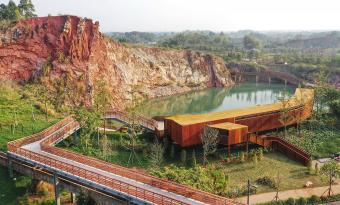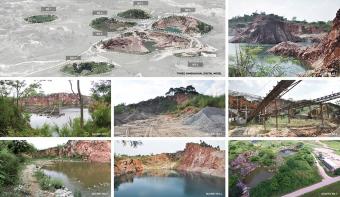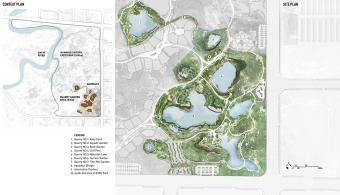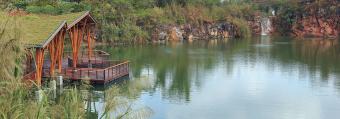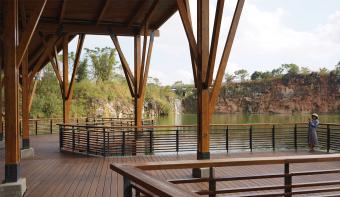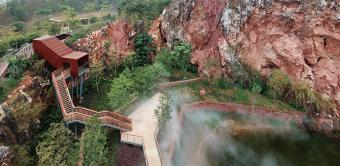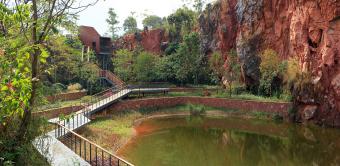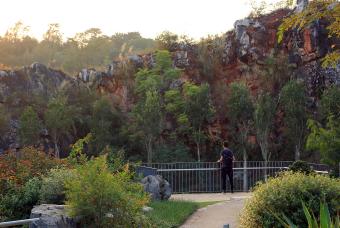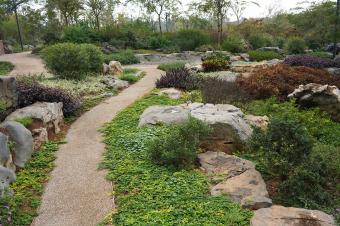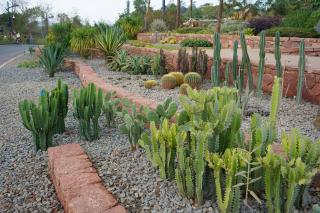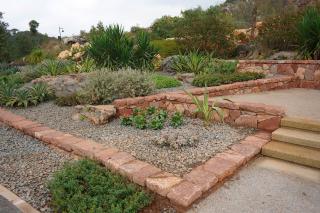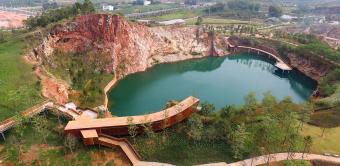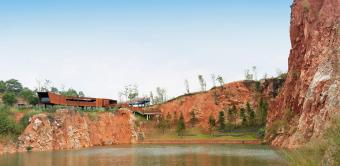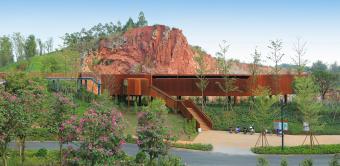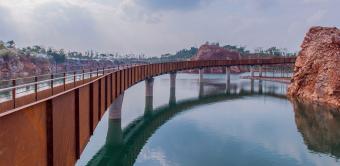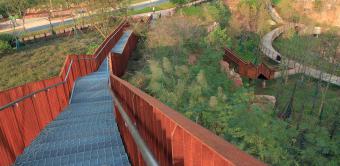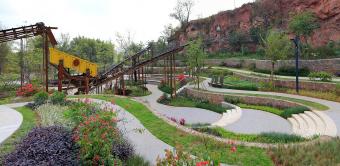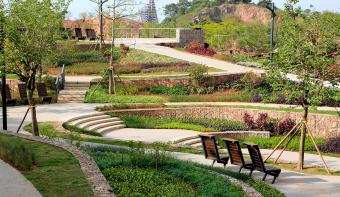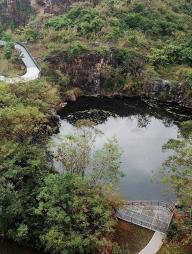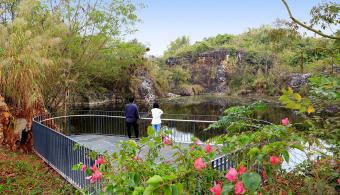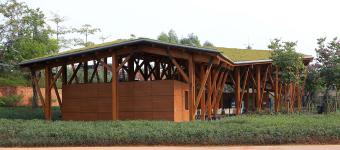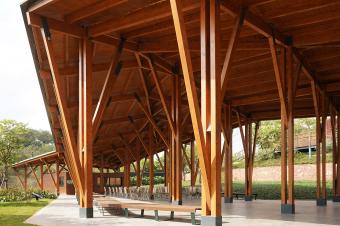2018年中國(guó)國(guó)際園林博覽會(huì)在南寧市舉辦�����。園博園選址于城市郊區(qū)的一片濱河的丘陵農(nóng)業(yè)區(qū),但場(chǎng)地東南區(qū)域分布著一系列的采石場(chǎng)�����。組委會(huì)希望將這些采石場(chǎng)轉(zhuǎn)變?yōu)閳@林博覽會(huì)中的有特色的園林����,成為展覽的一部分��。設(shè)計(jì)面積約33公頃����。場(chǎng)地上共7個(gè)采石場(chǎng),有的已停采了幾年����,有2個(gè)直到園博會(huì)申辦成功時(shí)才停止開(kāi)采。由于開(kāi)采采用的是爆破方式����,因此開(kāi)采面崖壁破碎,坑底高低不平。采石場(chǎng)留下的是破碎的丘陵����,高聳的懸崖,荒蕪的地表���,深不見(jiàn)底的水潭����,成堆的渣土渣石�,和生銹的采石設(shè)備。
2018 China International Garden Expo was held in Nanning, positioned along a river in the city’s hilly outskirts. Interspersed in the southeast section of the site is a series of quarries. The organizing committee hoped to transform seven of the relatively intact quarries into distinctive gardens displaying in the garden expo. The site covers an area of about 33 hectares. Several years had passed since mining at some of the quarries onsite ceased, yet two of the quarries persisted mining activities until the city won the expo bid. These quarries suffered blasting during the mining that caused fragmented surfaces and rugged landforms at pit bottom. The site was strewn with dilapidated hills, towering cliffs, deserted land surfaces, bottomless ponds, piles of abandoned soil and gravel, rusty quarrying equipment, etc.
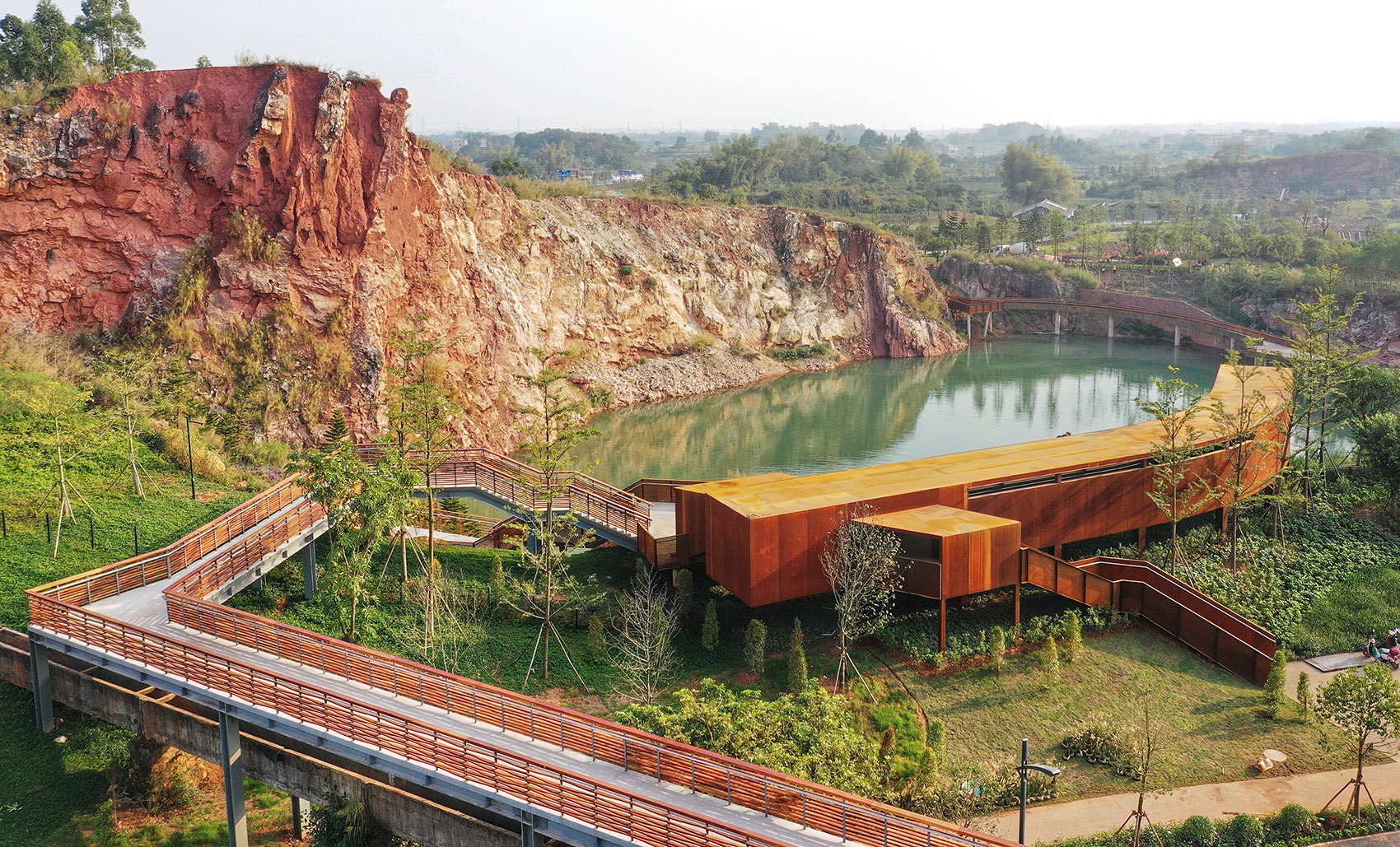
▲項(xiàng)目概覽��,general view ? 北京多義景觀規(guī)劃設(shè)計(jì)事務(wù)所
設(shè)計(jì)面臨著一系列巨大的挑戰(zhàn):采石場(chǎng)地質(zhì)情況復(fù)雜��,巖壁破碎�,有崩塌落石的可能,有不可預(yù)知的安全隱患����;采石場(chǎng)生態(tài)環(huán)境破壞嚴(yán)重,植被的修復(fù)面臨很大挑戰(zhàn)�;采石坑的地貌極其復(fù)雜,無(wú)法依據(jù)現(xiàn)狀測(cè)繪圖紙進(jìn)行設(shè)計(jì)�����;采石坑的水位一直在變化,尤其是最后停采的2個(gè)采石場(chǎng)��,水位一直在持續(xù)上升�����。設(shè)計(jì)沒(méi)有有效的水文數(shù)據(jù)���。
The project faces a series of huge challenges:1. The quarries presented extremely complex landforms that imposed design challenges in accordance to current mapping images. 2. Water levels in the quarries were unstable. In fact, two of the quarries that stopped mining later showed sustained rising water levels. Very limited valid hydrological data were available. 3. The geological conditions of the quarries were complex and the cliffs were dilapidated. The possibility of collapse and rock fall present unpredictable safety risks. 4. The quarries’ ecological environment was severely damaged and the restoration of vegetation was faced with great challenges.
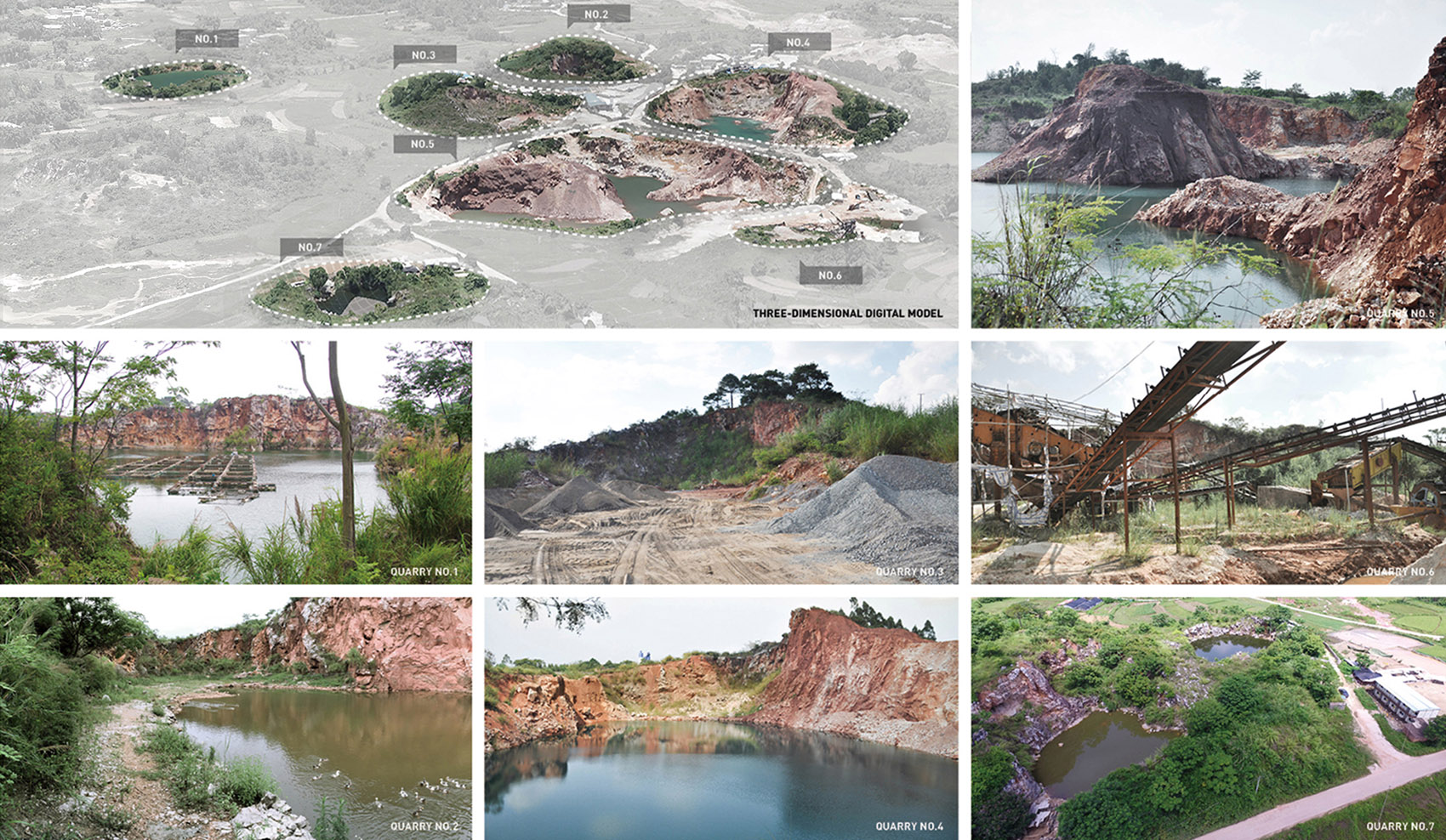
▲現(xiàn)狀條件,Site Context ? 北京多義景觀規(guī)劃設(shè)計(jì)事務(wù)所
為了精確地開(kāi)展設(shè)計(jì)����,設(shè)計(jì)師通過(guò)無(wú)人機(jī)航拍掃描,得到所有采石場(chǎng)的三維數(shù)字模型���,設(shè)計(jì)得以從始至終在三維空間上進(jìn)行���。設(shè)計(jì)師還委托當(dāng)?shù)貦C(jī)構(gòu)每半個(gè)月記錄一次每個(gè)坑中水位變化的情況,為設(shè)計(jì)提供依據(jù)�����。同時(shí),設(shè)計(jì)師根據(jù)不同采石場(chǎng)植被恢復(fù)的目標(biāo)��,引入土壤��,形成不同土壤厚度的種植區(qū)域�,為恢復(fù)生境創(chuàng)造條。在設(shè)置設(shè)施和參觀路徑的時(shí)候?qū)踩苑旁谑孜?���,在突出采石?chǎng)景觀特色的同時(shí)避讓危險(xiǎn)區(qū)域。7個(gè)采石場(chǎng)看起來(lái)很相似���,但實(shí)際上每個(gè)的尺度�����、形態(tài)和特征都不相同��。針對(duì)不同的場(chǎng)地特征��,設(shè)計(jì)采用了差異化的植被修復(fù)方法和人工介入方式���。
Through an aerial scanning of UAV, landscape architects obtained three-dimensional digital models of all quarries, on this basis the design could well match the site landforms. To provide relevant data required for the design, a local institution was assigned to record changes in the water levels of each quarry every half month. With safety as primary consideration, the setting of facilities and various paths intentionally avoid dangerous zones, while highlighting distinctive features of the quarry landscape. Moreover, safety measures were strictly implemented where necessary to prevent cliff-slide rock falls. According to the different goals of vegetation restoration, soil was introduced to earth up planting areas forming different soil thicknesses to create conditions for habitat restoration of the particularly large number of native plant species. Stones, gravels, mucks, and mining machines on the site are reasonably preserved and reused in the new landscape. Although similar in appearance, the quarries vary from each other greatly in terms of scale, space structure, and characteristics. Landscape architects adopted various methods of intervention and vegetation restoration that complement each quarry’s distinctive qualities.
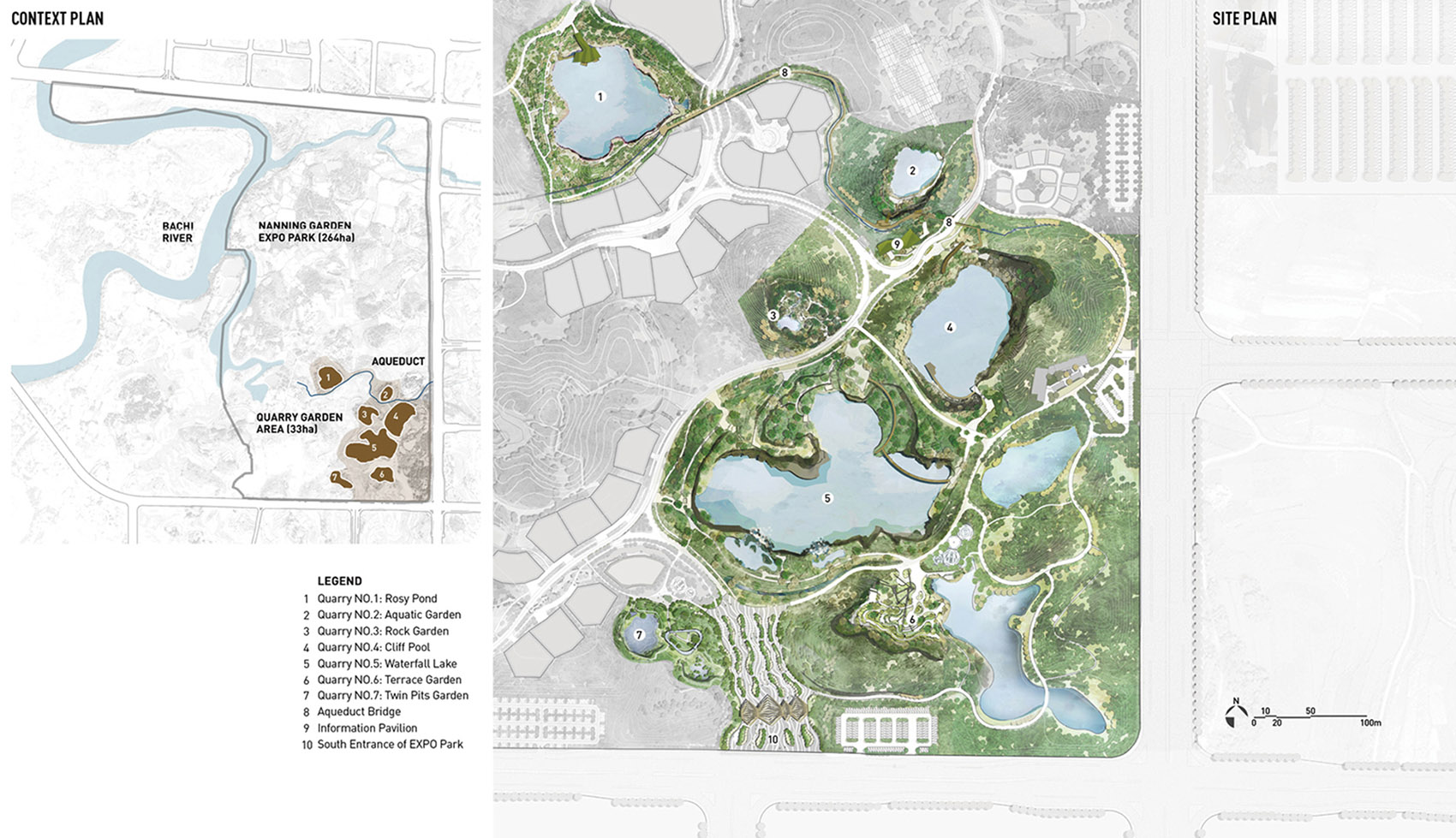
▲場(chǎng)地平面圖和總平面圖 ,Context Plan and Site Plan ? 北京多義景觀規(guī)劃設(shè)計(jì)事務(wù)所
1號(hào)采石場(chǎng)(落霞池)
Quarry No. 1
這個(gè)面積約1hm2的采石場(chǎng)�����,由于停采之后地下水滲出,形成了一個(gè)由巖石包圍的寧?kù)o池塘��,被附近村民用于養(yǎng)魚(yú)���。環(huán)繞池塘的石壁雄渾厚重����,非常符合中國(guó)傳統(tǒng)藝術(shù)對(duì)巖石的審美�����。設(shè)計(jì)試圖體現(xiàn)中國(guó)傳統(tǒng)的風(fēng)景美學(xué)�����。一個(gè)不規(guī)則形狀的木結(jié)構(gòu)建筑被嵌入池塘邊緣的巖石豁口中��,其結(jié)構(gòu)形式從當(dāng)?shù)氐泥l(xiāng)土建筑中獲得靈感���。
Quarry No. 1 is a one-hectare quiet pond walled within a rough rock hedge, in which China’s traditional landscape aesthetics is attempted to be embodied. A wooden and irregularly-shaped pavilion is nestled within a rock gap at the edge of a pond, whose structural form is inspired by the local vernacular architecture.
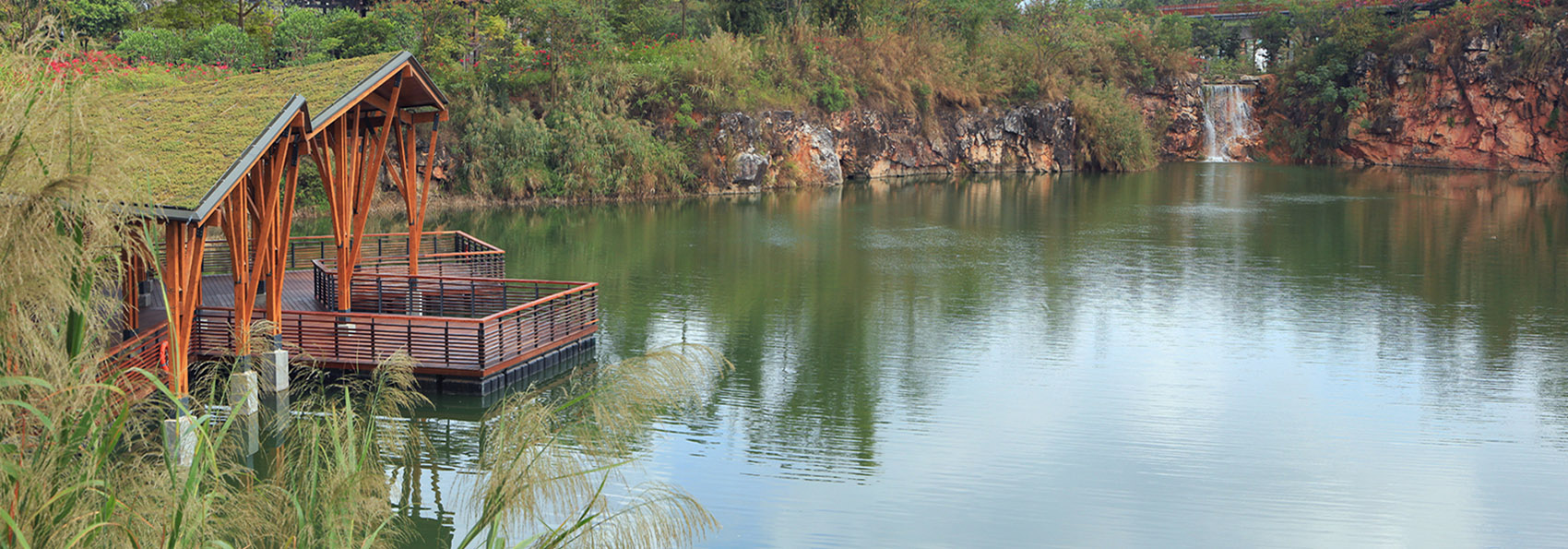
▲景觀要素呈現(xiàn)出中國(guó)傳統(tǒng)的詩(shī)意的風(fēng)景美學(xué),landscape elements well-depict the China’s traditional poetic landscape aesthetics ? 北京多義景觀規(guī)劃設(shè)計(jì)事務(wù)所
從陸地到水面����,建筑從狹長(zhǎng)的廊子轉(zhuǎn)變?yōu)樗叺拇笸ぷ?���。為適應(yīng)水位的變化��,亭子的地板是浮動(dòng)的��。游客在這里可以欣賞對(duì)面的巖壁和瀑布�����。瀑布為這個(gè)采石坑增加了景觀的動(dòng)態(tài)變化���,潺潺的水聲增添了寧?kù)o悠遠(yuǎn)的氣氛��。水岸的一條小徑聯(lián)系了4處不同標(biāo)高的平臺(tái)��,為人們提供了從不同的角度觀賞巖石�����、瀑布和建筑的場(chǎng)所���。水邊巖石上種滿了紅色的三角梅����,懸垂下來(lái)�����,倒影在池塘中���。
It provides visitors with a panorama of green pond and encircling cliff, and babble waterfall on the diagonal opposite. To adapt to the unstable water levels, the pavilion floor is designed floated. A waterfront path links four platforms with varying elevations, offering people with all-round perspectives to enjoy the scenery.
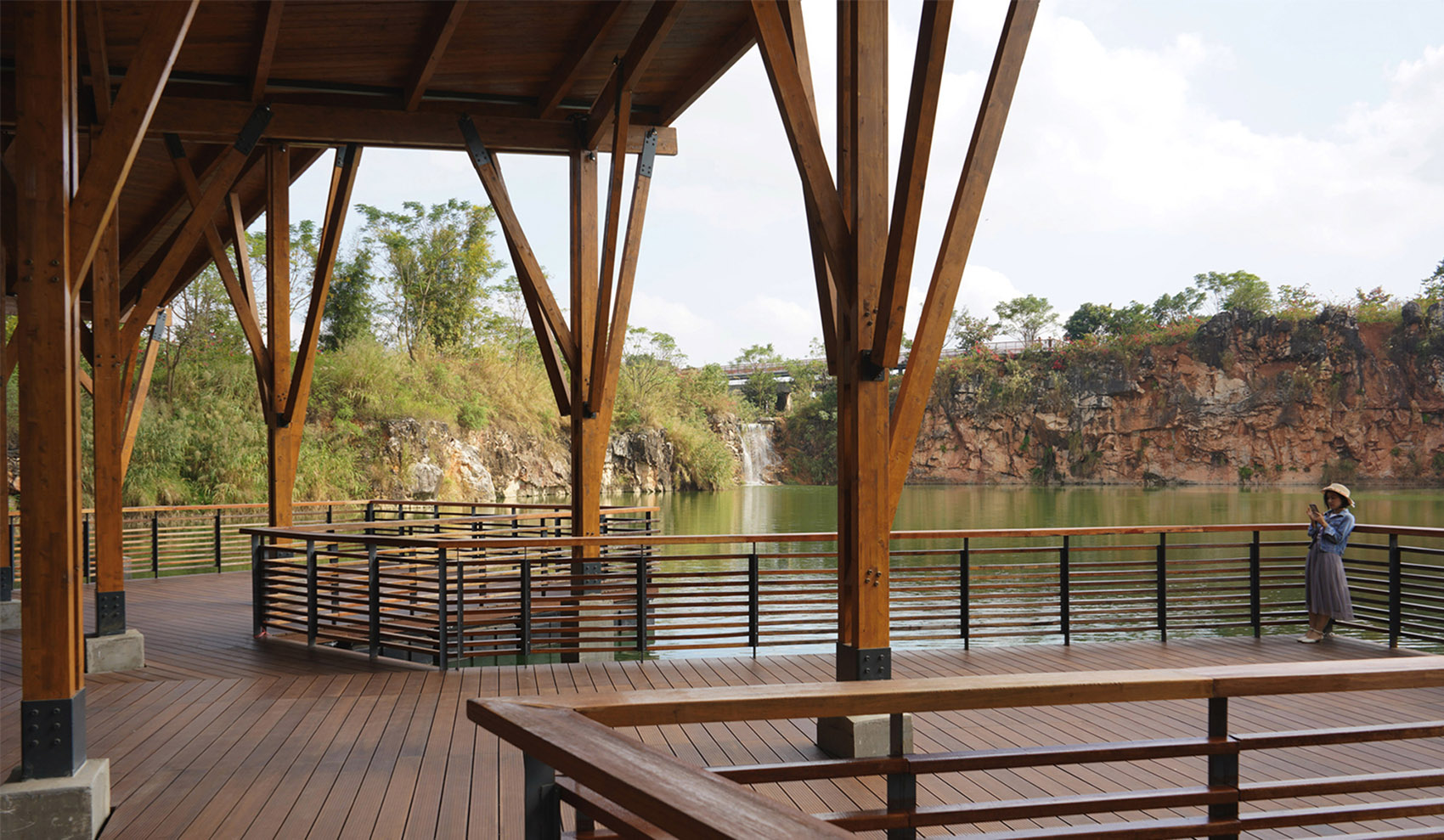
▲亭子的結(jié)構(gòu)形式從當(dāng)?shù)氐泥l(xiāng)土建筑中獲得靈感����,the structural style of the pavilion is inspired by vernacular architecture ? 北京多義景觀規(guī)劃設(shè)計(jì)事務(wù)所
2號(hào)采石場(chǎng)(水花園)
Quarry No. 2
采石場(chǎng)面積僅為0.4 hm2����,四周巖壁環(huán)繞,坑底較平緩����,低處常年有積水�,是周圍村莊鴨子嬉戲的樂(lè)園。它被設(shè)計(jì)成為一個(gè)濕生植物花園��。覆土形成的緩坡從淺水區(qū)一直延伸至岸上��,種植了40多種水生和濕生植物。在地勢(shì)較高處設(shè)計(jì)了兩層臺(tái)地�����,種植喬灌木����,為花園創(chuàng)造了背景,也遮擋了破碎的巖壁����。山崖上方有路徑與采石坑底部連接,最高的一段是封閉的木盒�����,既是安全的步行通道���,也是一個(gè)空中觀景臺(tái)���,人們可在此欣賞巖壁,俯瞰花園����。木盒下方有一個(gè)寬大的平臺(tái)��,平臺(tái)引出的之字形鋼格柵棧道從濕生植物種植區(qū)穿過(guò)��。
Quarry No. 2 is surrounded by cliffs on all sides����,with an area of only 0.4 ha. The quarry bottom is relatively flat and accumulates water perennially. The quarry is designed as an aquatic garden. The zigzag steel grating walkway winds through the planting zone and connects to a platform that further extends to a path above the cliff, accessed by several flights of steps. The section with the highest elevation features a closed wooden box, which is also an aerial viewing platform where people can appreciate a captivating view of the cliff and the entire garden expanse.
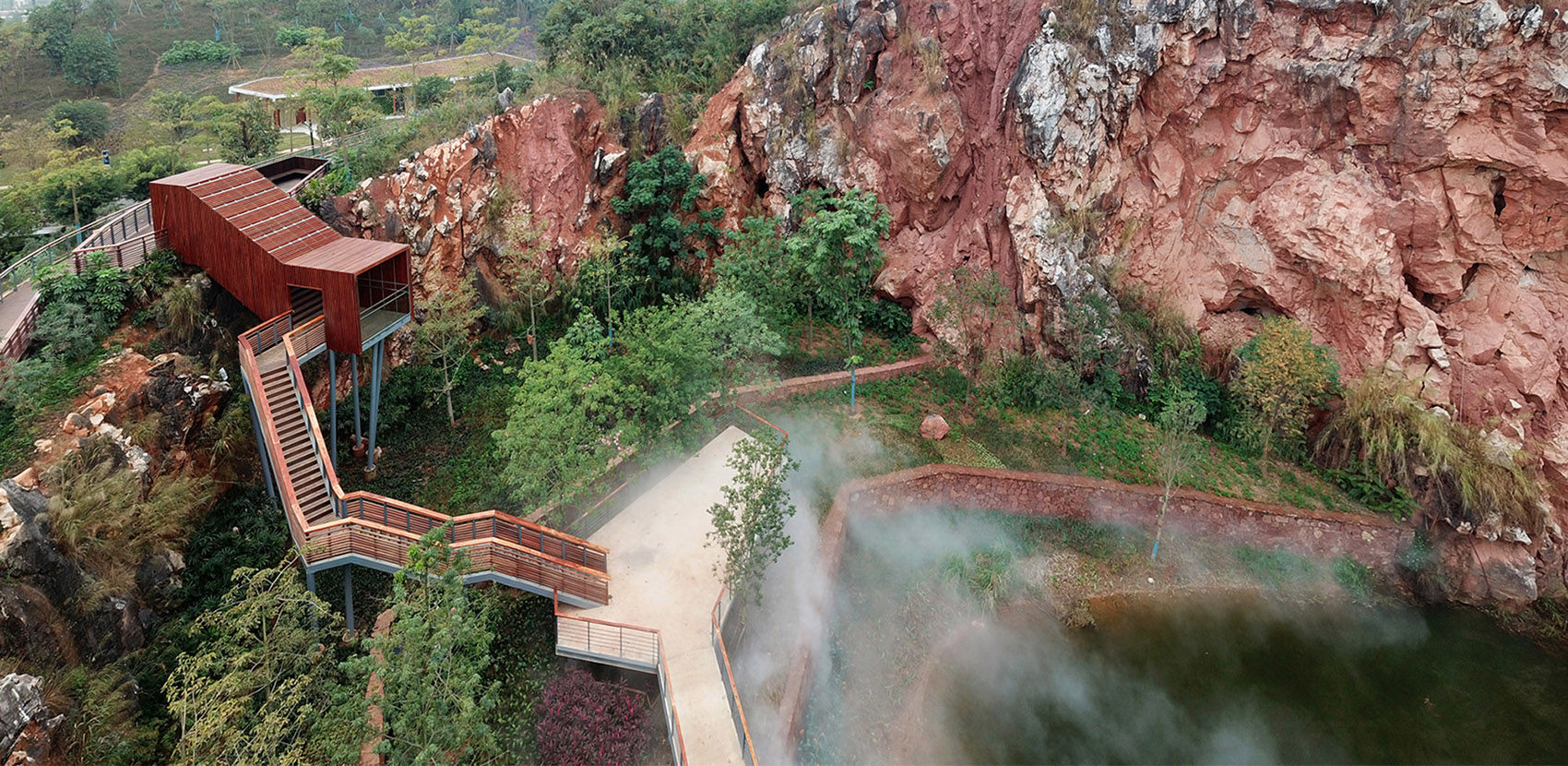
▲2號(hào)采石場(chǎng)被設(shè)計(jì)成濕生植物花園�,the quarry was transformed as an aquatic plant garden ? 北京多義景觀規(guī)劃設(shè)計(jì)事務(wù)所
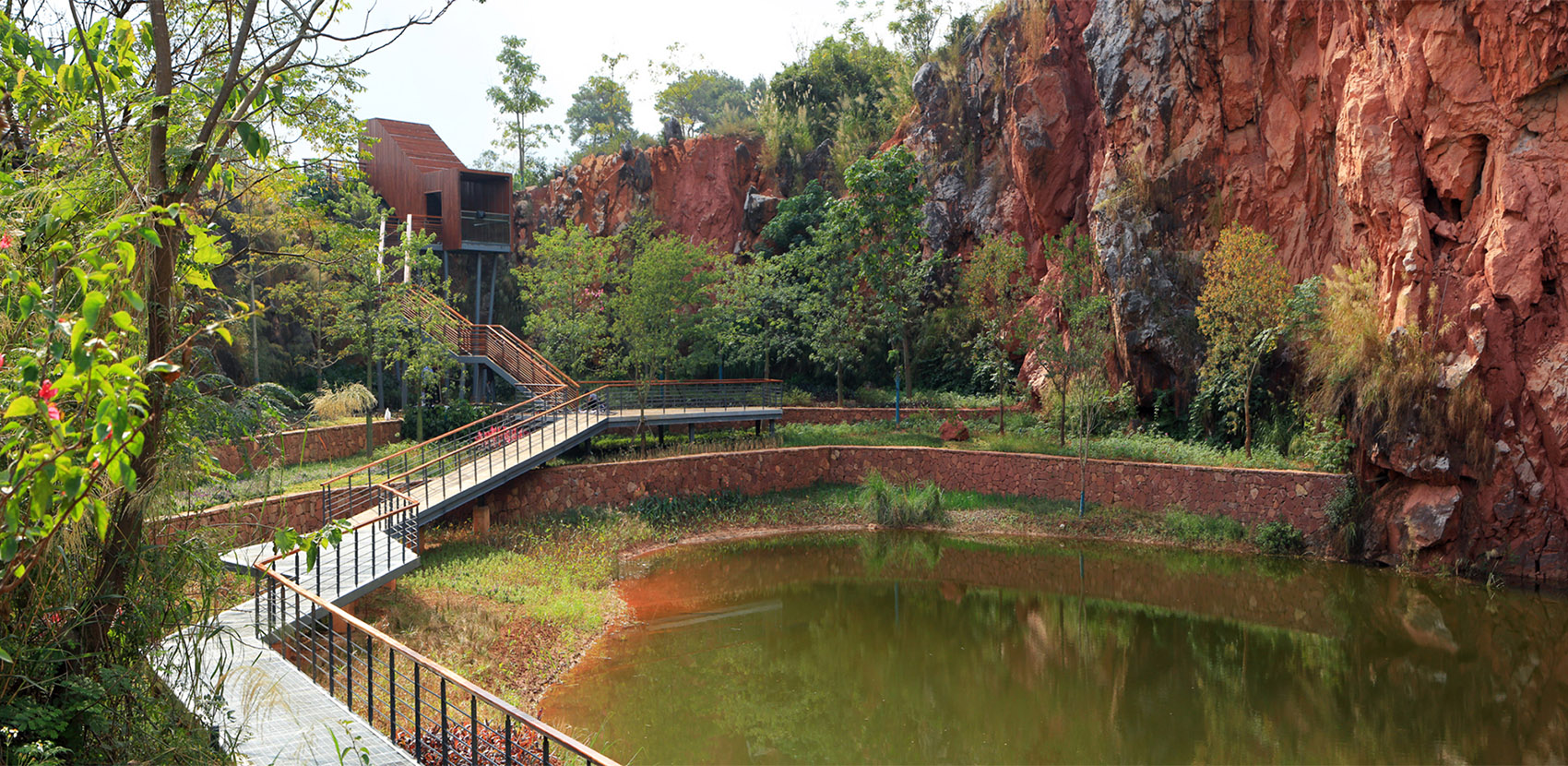
▲一條路徑連接了山崖上方的水渠棧道與采石坑底部的平臺(tái),a path connects cliff-top to the platform at the pit-bottom ? 北京多義景觀規(guī)劃設(shè)計(jì)事務(wù)所
3號(hào)采石場(chǎng)(巖石園)
Quarry No. 3
這個(gè)0.4hm2采石場(chǎng)基址呈碗狀���,三面環(huán)繞巖壁��,一側(cè)地面堆放了大量渣石和渣土�����。受到巖石縫隙中萌發(fā)的植物的啟發(fā)��,我們將這個(gè)采石場(chǎng)設(shè)計(jì)為精致的巖石園����。設(shè)計(jì)將原有的渣石渣土整理后塑造出地形的骨架�,然后在上面覆蓋種植土。微妙的地形變化不僅創(chuàng)造出干燥和濕潤(rùn)等不同的生境���,為不同植物生長(zhǎng)提供條件����,也把場(chǎng)地雨水收集到最低的凹陷區(qū)���。
Quarry No. 3 is bordered by the cliff on three sides and was designed as a delicate rock garden. The abandoned soil and gravel on site were utilized as the base of the garden’s subtle landform, with planting soil wrapping its surface. A moderately-sized terrace garden is designed near the main road, creating a unique desert plant landscape.
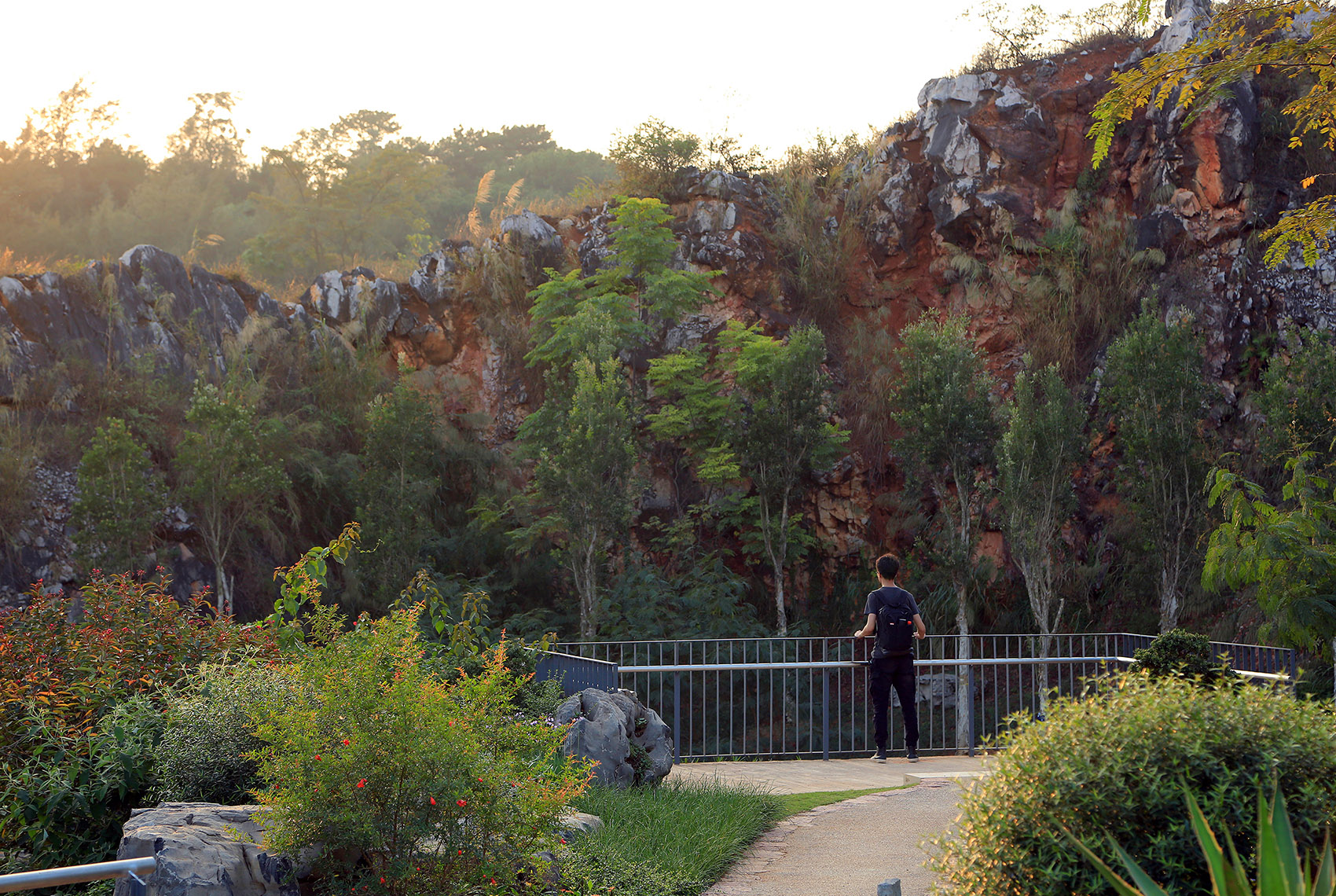
▲采石場(chǎng)基址呈碗狀�����,三面環(huán)繞巖壁 ��,Quarry No. 3 is bordered by the cliff on three sides and was designed as a delicate rock garden ? 北京多義景觀規(guī)劃設(shè)計(jì)事務(wù)所
緊鄰主園路設(shè)計(jì)了幾層尺度親切��、變化豐富的臺(tái)地來(lái)化解高差�。臺(tái)地上種植了仙人掌和多肉多漿等沙生植物����,營(yíng)造出極富特色的沙漠植物景觀。中間緩坡區(qū)展現(xiàn)荒原植物景觀�。底部凹陷區(qū)被設(shè)計(jì)為濕生巖石園,有溪流層層跌落至最低處的池塘��。兩個(gè)標(biāo)高不同的平臺(tái)位于凹陷區(qū)的邊緣,人們可以憑欄觀賞溪流跌水�。
The gentle-sloping section in the center consists of a dry garden, while the southern concave section showcases hygrophilous rock plants with water cascading into the lowest pond. Two platforms with different elevations are constructed at the edge of the concave area, where people can enjoy a charming view of the garden.
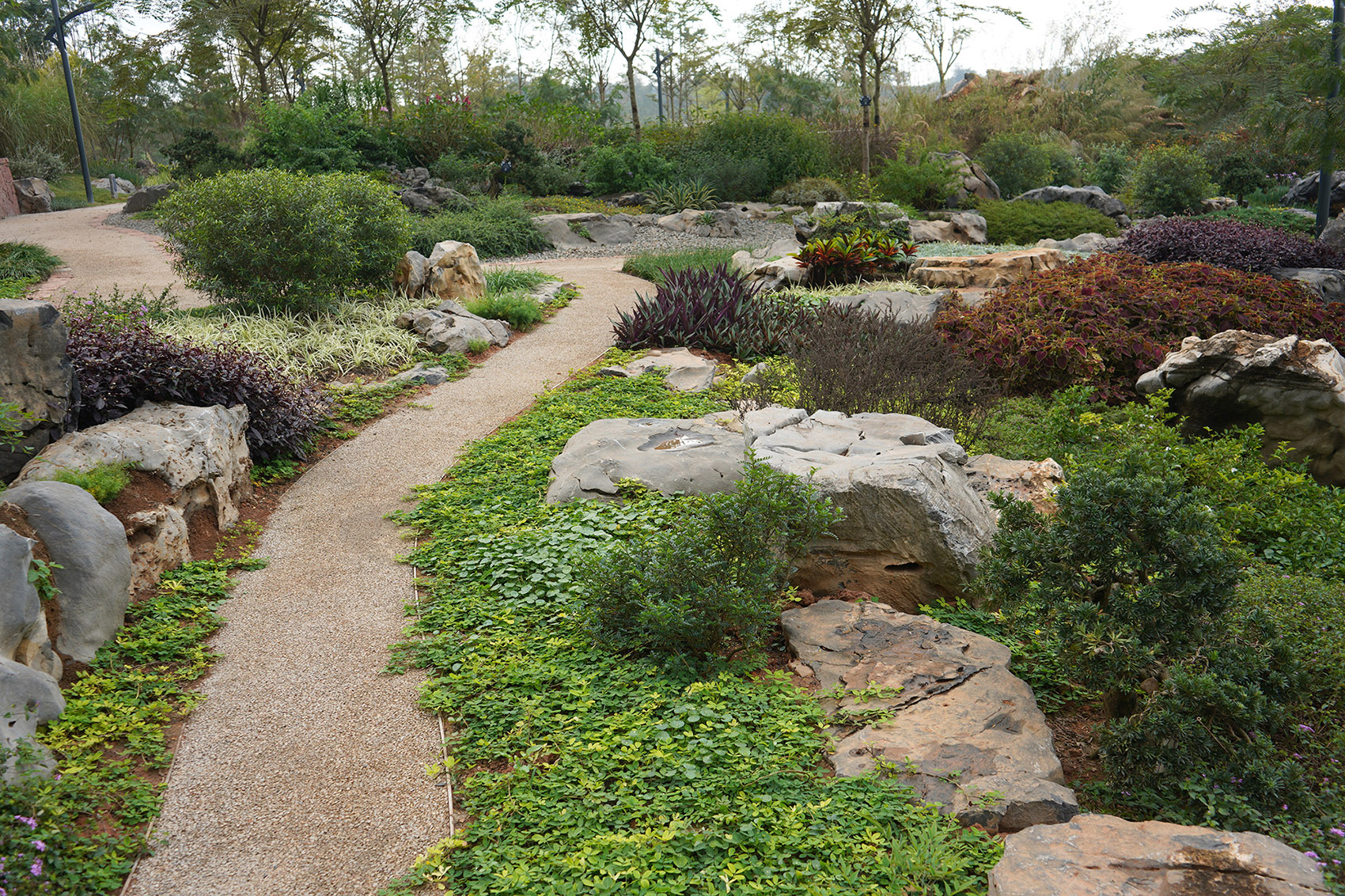
▲采石場(chǎng)設(shè)計(jì)為精致的巖石園, delicate rock garden ? 北京多義景觀規(guī)劃設(shè)計(jì)事務(wù)所
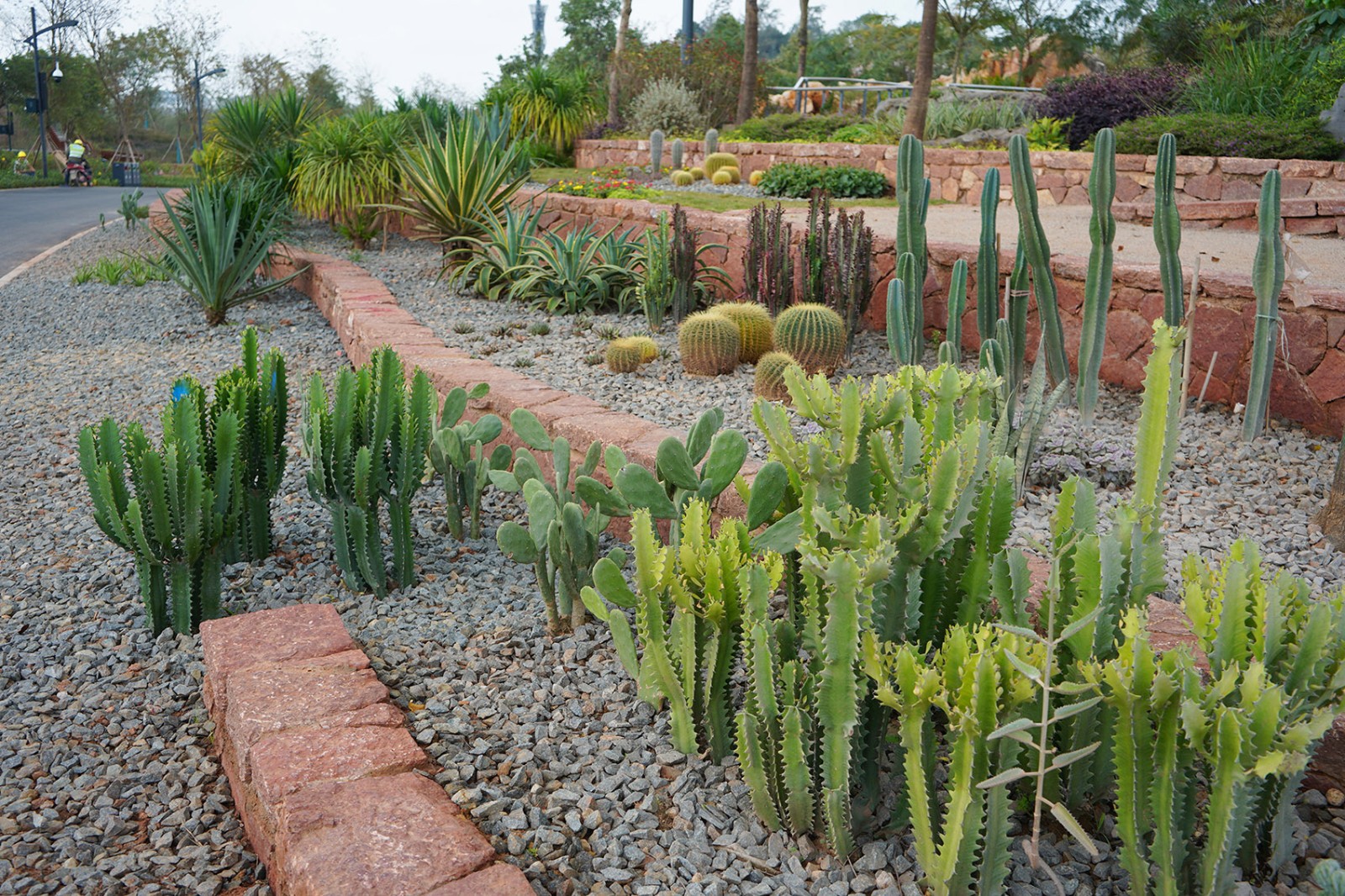
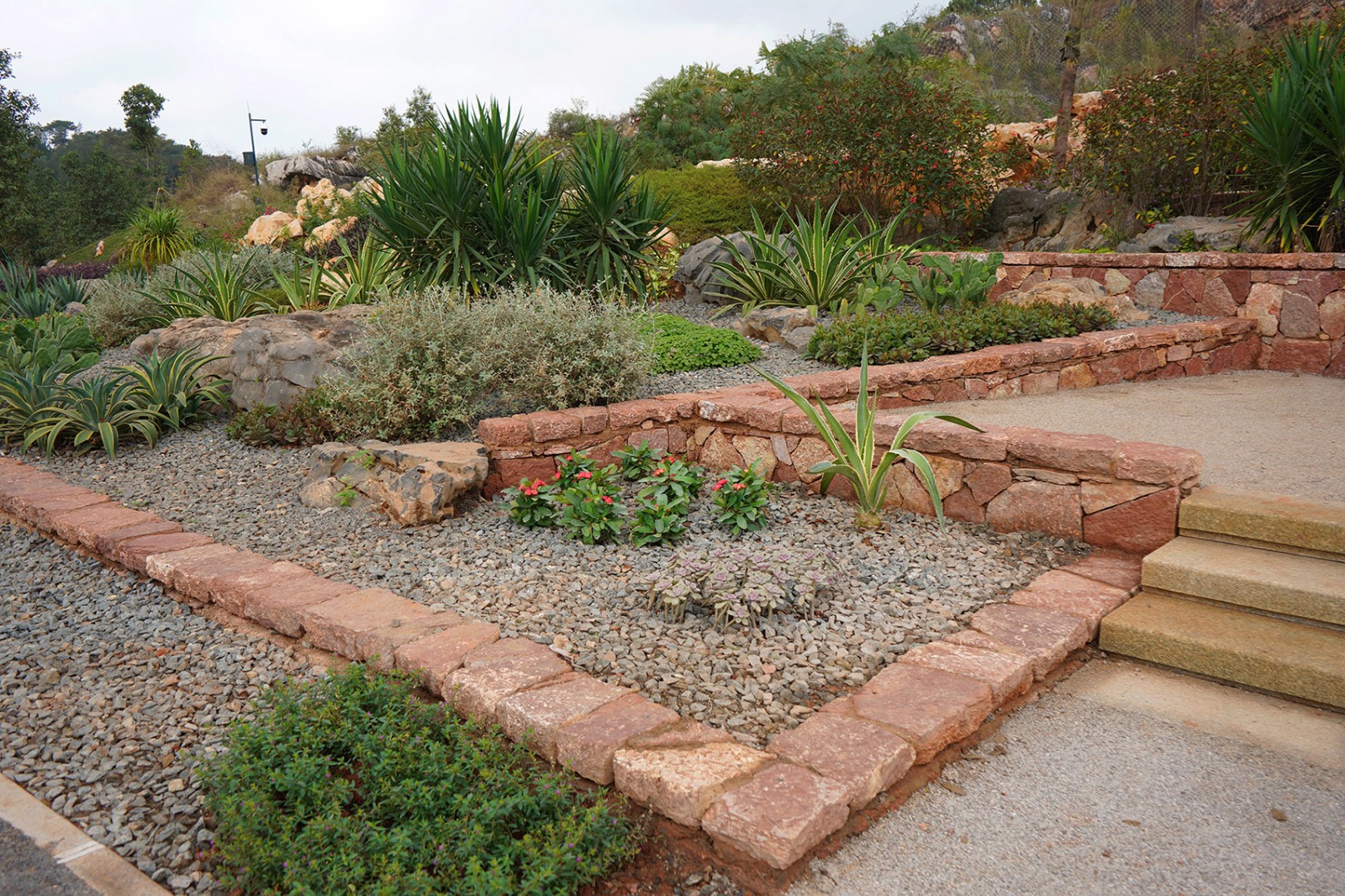
▲變化豐富的臺(tái)地與沙漠植物景觀��, moderately-sized terrace garden and desert plant landscape ? 北京多義景觀規(guī)劃設(shè)計(jì)事務(wù)所
4號(hào)采石場(chǎng)(峻崖潭)
Quarry No. 4
采石場(chǎng)停采之后滲透出來(lái)的地下水匯成一個(gè)面積約1hm2的碧綠澄澈的大水潭�����。我們?cè)谀媳眱蓚?cè)主要觀賞點(diǎn)設(shè)置了平臺(tái)����。北側(cè)的觀景臺(tái)是一個(gè)位于采石場(chǎng)邊緣的耐候鋼長(zhǎng)廊,內(nèi)部朝向采石場(chǎng)打開(kāi)了一長(zhǎng)條帶形窗�����,在此可以望見(jiàn)對(duì)面高出水面40多米的高聳險(xiǎn)峻的懸崖��。長(zhǎng)廊南端懸挑在巖壁上���,人們站在玻璃欄桿內(nèi)側(cè)可以俯瞰腳下的一池碧水和對(duì)面的濱水平臺(tái)�����,驚險(xiǎn)刺激�。
Quarry No. 4 is a large pond embraced by cliffs, with green and clear water. Viewing platforms sit on both northern and southern sides of the quarry. The northern platform is a Corten steel corridor located at the quarry’s edge, unraveling a long strip window towards the quarry, where visitors can feast their eyes on the steep cliff towering over 40 meters above the water surface. At the southern end of the corridor, people can enjoy an overlooking view of the charming pond situated beneath and the waterfront platform on the opposite side, offering a thrilling and exciting experience.
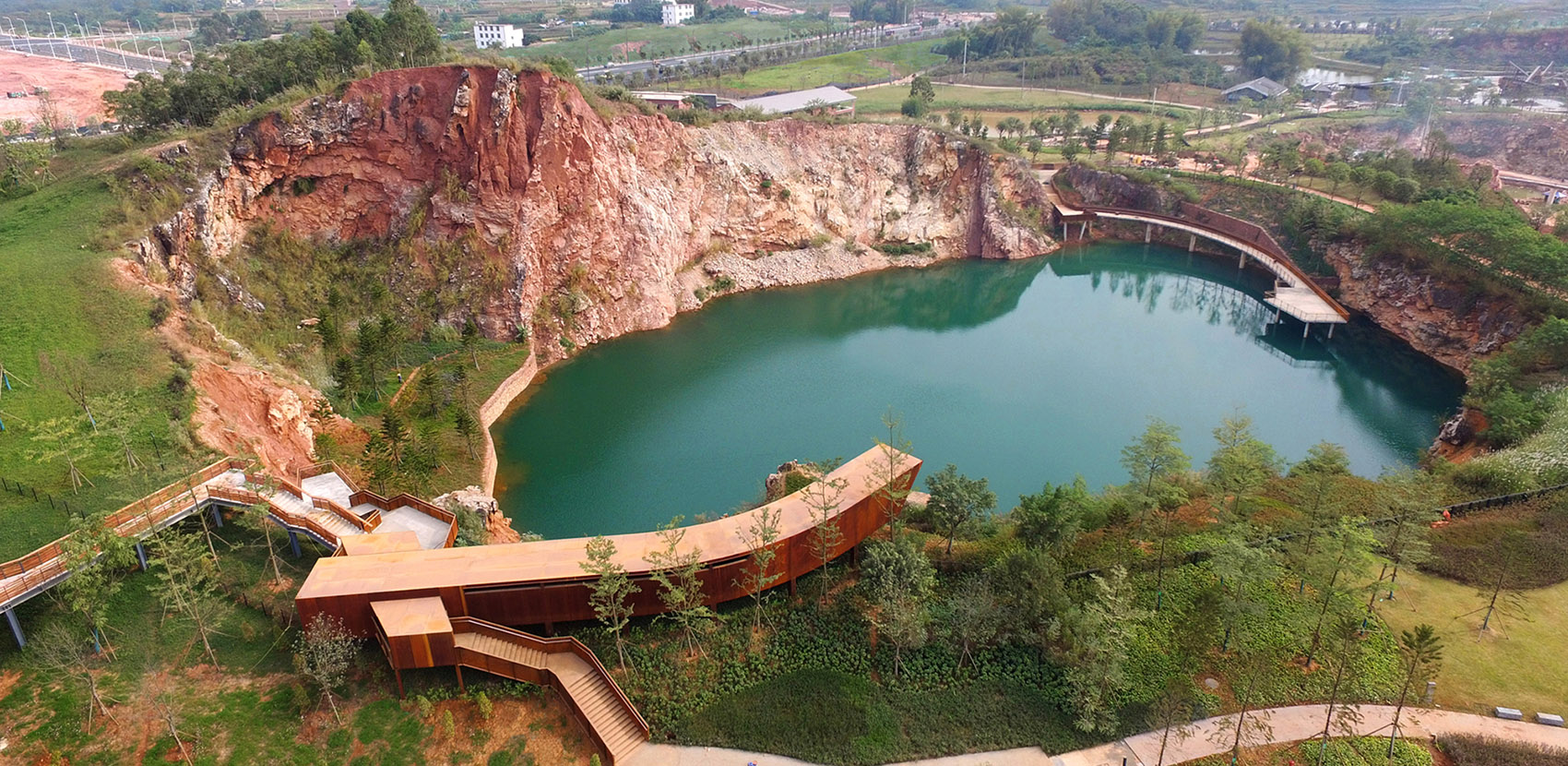
▲4號(hào)采石場(chǎng)俯瞰 ,aerial view of the quarry no.4 ? 北京多義景觀規(guī)劃設(shè)計(jì)事務(wù)所
采石坑南側(cè)�����,一個(gè)楔形平臺(tái)從山石的一個(gè)豁口探出�����,懸挑于碧水之上�,一條曲線的棧橋從平臺(tái)引出��,連接低處的濱水平臺(tái)���?���?芋w周圍和和坑內(nèi)緩坡處通過(guò)覆土��,種植了南洋杉和一些鄉(xiāng)土灌木及草本���,使采石場(chǎng)有了生機(jī)并襯托出崖壁的險(xiǎn)峻��。
On the southern side of the quarry, a wedge-shaped platform stretches out from a gap among the rocks. It hangs above the waters and connects to the lower waterfront platform through a curved bridge. Through an earthing-up process, vegetation was restored around the quarry as well as the gentle slope inside, which revives the quarry garden meanwhile highlights the steepness of cliffs.
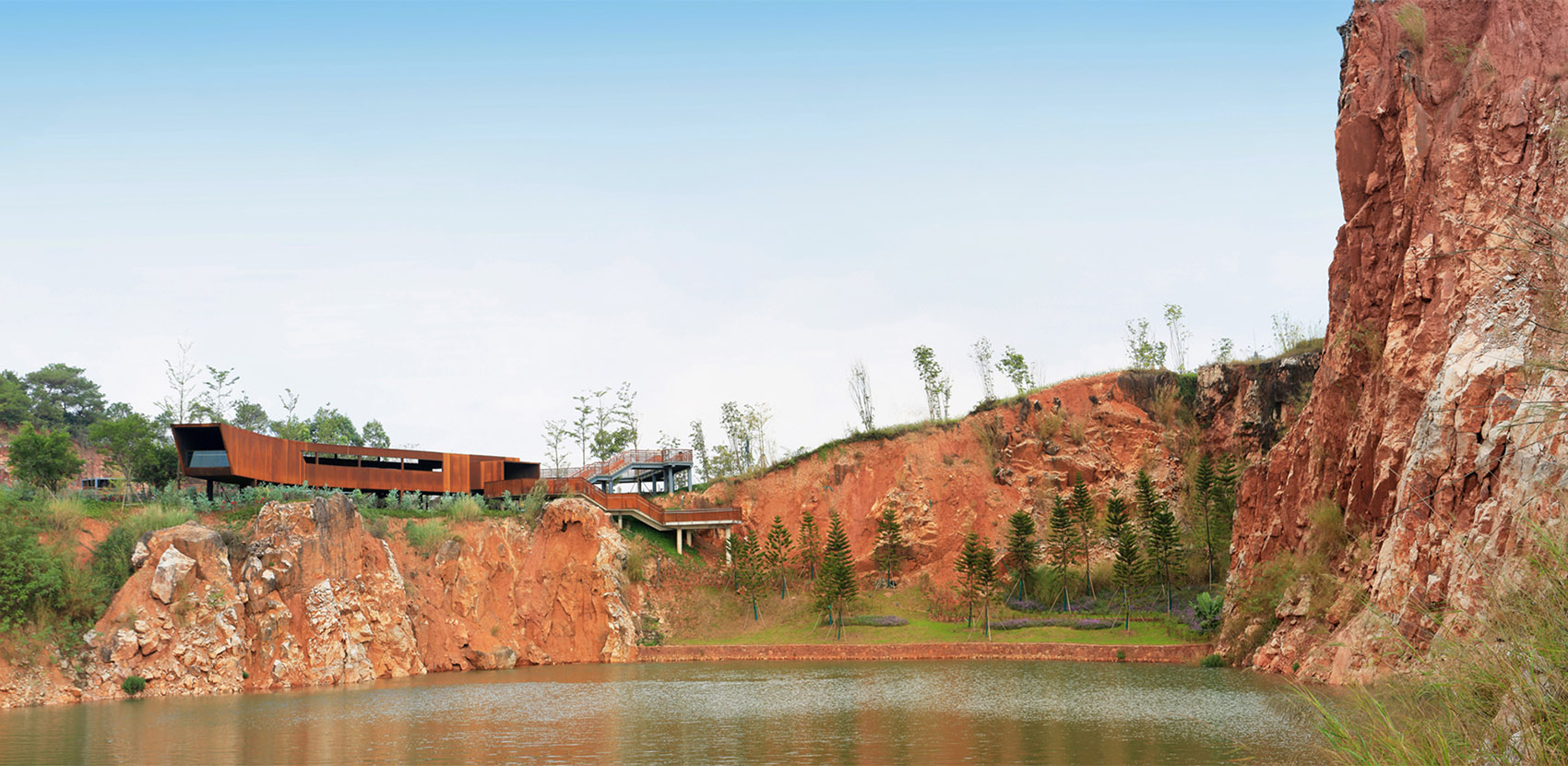
▲采石坑北側(cè)的高處的長(zhǎng)廊和南側(cè)低處的棧橋和平臺(tái)�,The higher corridor on the north side of the quarry and the lower boardwalk with platform on the south ? 北京多義景觀規(guī)劃設(shè)計(jì)事務(wù)所
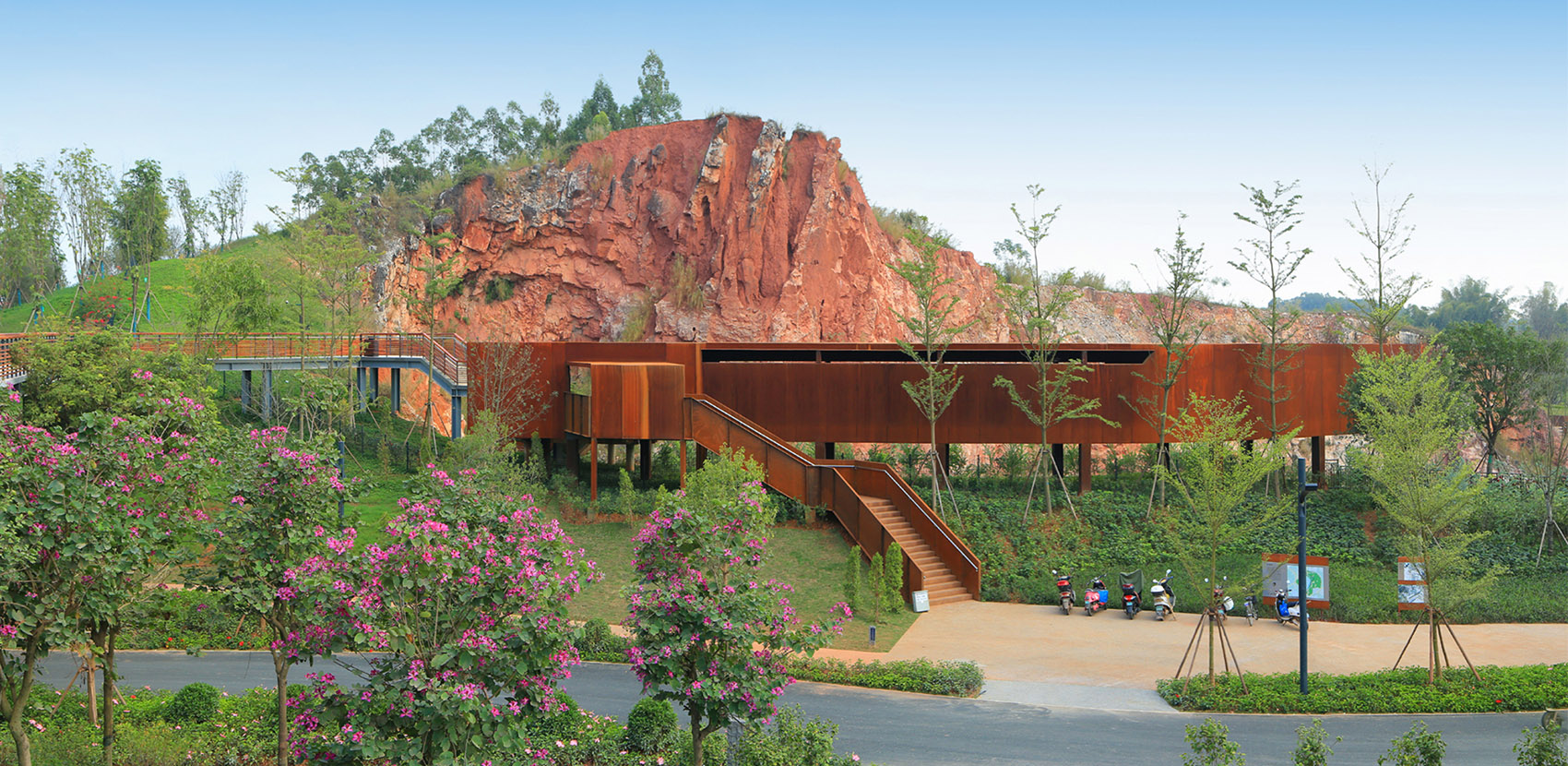
▲懸于峭壁之上的耐候鋼長(zhǎng)廊,the Corten steel corridor on the edge of the quarry ? 北京多義景觀規(guī)劃設(shè)計(jì)事務(wù)所
5號(hào)采石場(chǎng)(飛瀑湖)
Quarry No. 5
這個(gè)面積最大的采石場(chǎng)約3.2hm2�����,開(kāi)采深度也最深��,達(dá)28m�,底部呈現(xiàn)幾層巖臺(tái),崖壁破碎��。隨著地下水逐漸蓄積�,水位不斷上升。根據(jù)水位觀測(cè)和分析���,我們判斷最終整個(gè)采石坑將成為一片湖面��。設(shè)計(jì)師通過(guò)覆土將采石坑底部?jī)善_(kāi)采深度相對(duì)較淺的區(qū)域抬高到水面之上���,并種植耐濕高大喬木如池杉和水松,形成水上叢林����,為荒涼的坑體內(nèi)部帶來(lái)綠色和生機(jī)。然后用不同高度的棧橋引導(dǎo)人們進(jìn)入采石坑內(nèi)部����,穿越水面和樹(shù)林���,通往岬角高處的觀景臺(tái),在下降和攀登的探索中體驗(yàn)空間和景觀的變化��。為了增加景觀的豐富性�����,棧橋?qū)γ娴难卤谏显O(shè)計(jì)了飛流而下的瀑布��,人們可以在橋上觀賞到精彩的瀑布景觀��。
Quarry No. 5 is the largest among the seven quarries, enclosed by dilapidated cliff with terraced rocks sitting at the bottom. The quarry has transformed into a lake, caused by the continuously-rising water level. Two areas with relatively shallow mining depths were earthed up above the water surface, and planted with trees such as pond cypress and Chinese cypress, creating an aquatic woods landscape. Bridges and walkways of varying heights crisscross above the water and through the woods, creating a connection with the hilltop view platform. A waterfall is designed on the opposite of the bridge, forming a scenery spot accordingly.
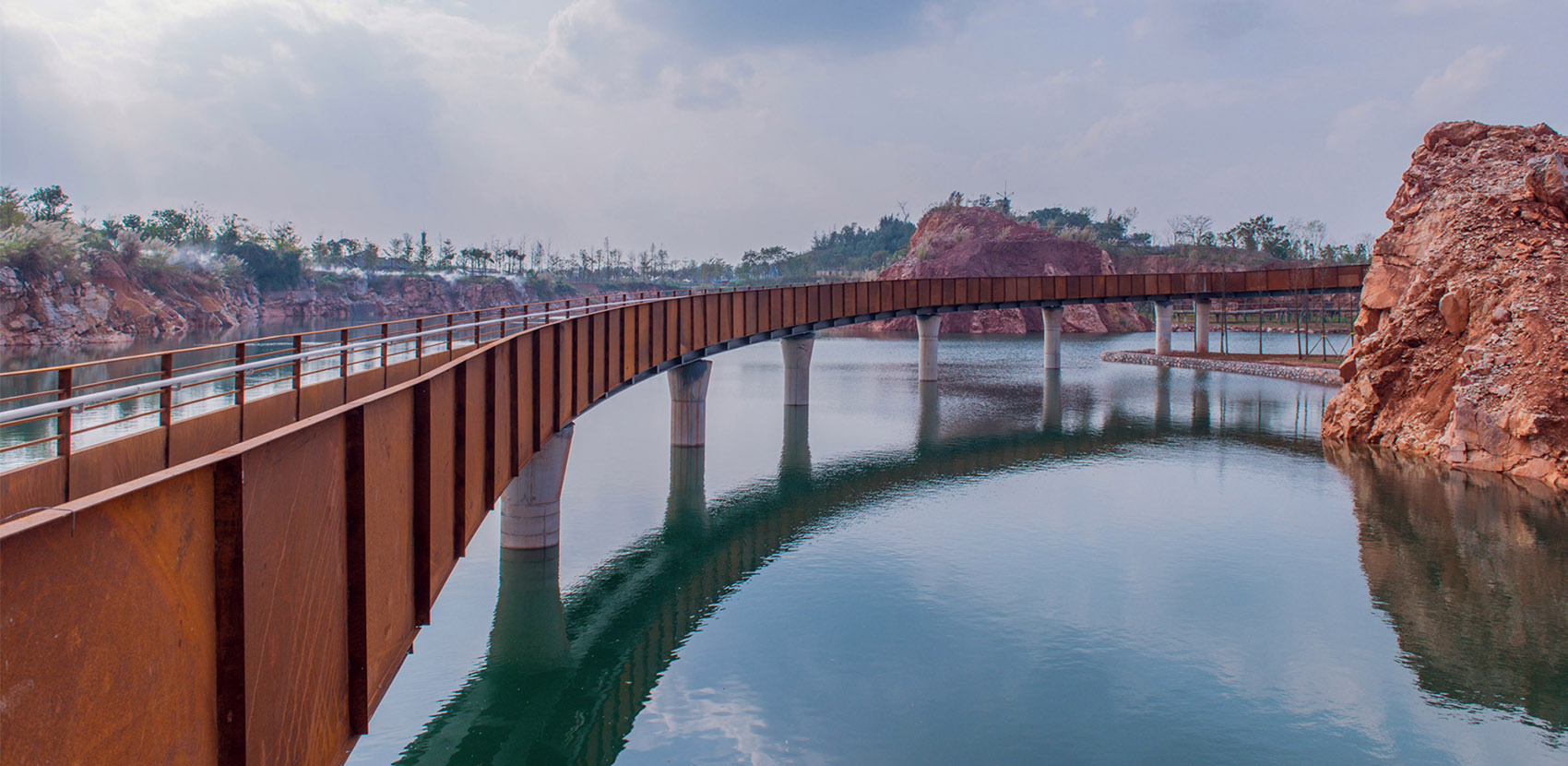
▲不同高度的棧橋引導(dǎo)人們進(jìn)入采石坑內(nèi)部 ��,bridges and walkways of varying heights crisscross above the water ? 北京多義景觀規(guī)劃設(shè)計(jì)事務(wù)所
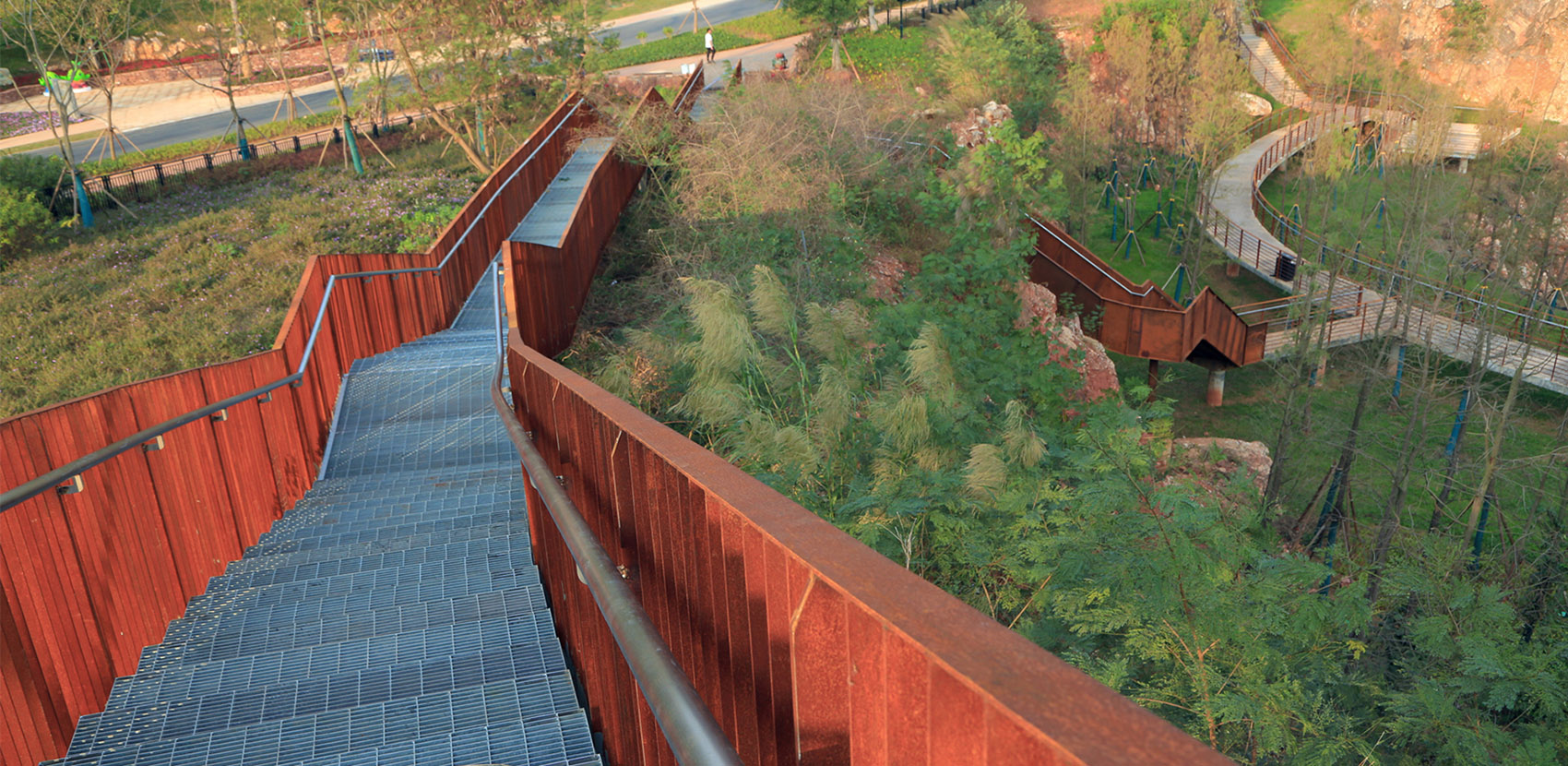
▲棧道通往山坡高處的觀景臺(tái)��,the Corten steel path leading to the viewing platform at the hilltop ? 北京多義景觀規(guī)劃設(shè)計(jì)事務(wù)所
6號(hào)采石場(chǎng)(臺(tái)地園)
Quarry No. 6
6號(hào)采石場(chǎng)一側(cè)是采石場(chǎng)崖壁�,一側(cè)是鄉(xiāng)村水塘�����,面積為0.7hm2�。場(chǎng)地上有制砂生產(chǎn)線的全套設(shè)備��,展現(xiàn)著場(chǎng)地采石工業(yè)的歷史����。它被塑造成具有后工業(yè)氣氛的浪漫絢麗的花園��。幾層臺(tái)地沿南側(cè)崖壁蜿蜒展開(kāi)��,它們的覆土厚度滿足不同植物生長(zhǎng)的需要���。機(jī)械設(shè)備大部分被置于綠地之中�����,生機(jī)勃勃的植物與銹跡斑斑的機(jī)械形成有趣的對(duì)比��。道路在不同高度的臺(tái)地中和原有高架傳送帶下方曲折穿過(guò)����,路邊設(shè)置了舒適的木質(zhì)靠背椅供人休息���。
Quarry No. 6 was transformed into a romantic and gorgeous garden with post-industrial atmosphere, utilizing sand production machines left onsite. Along the southern cliff are several terraces with various thicknesses of earthing soil, meeting the needs of various plants, from herbs to trees. Most of the leftover equipment was set in the verdant greens that contrast with the rusty machinery. The paths twist among the terraces of different heights and under the overhead conveyor belt. Wooden benches along the paths and platforms provide comfortable venues for rest and relaxation.
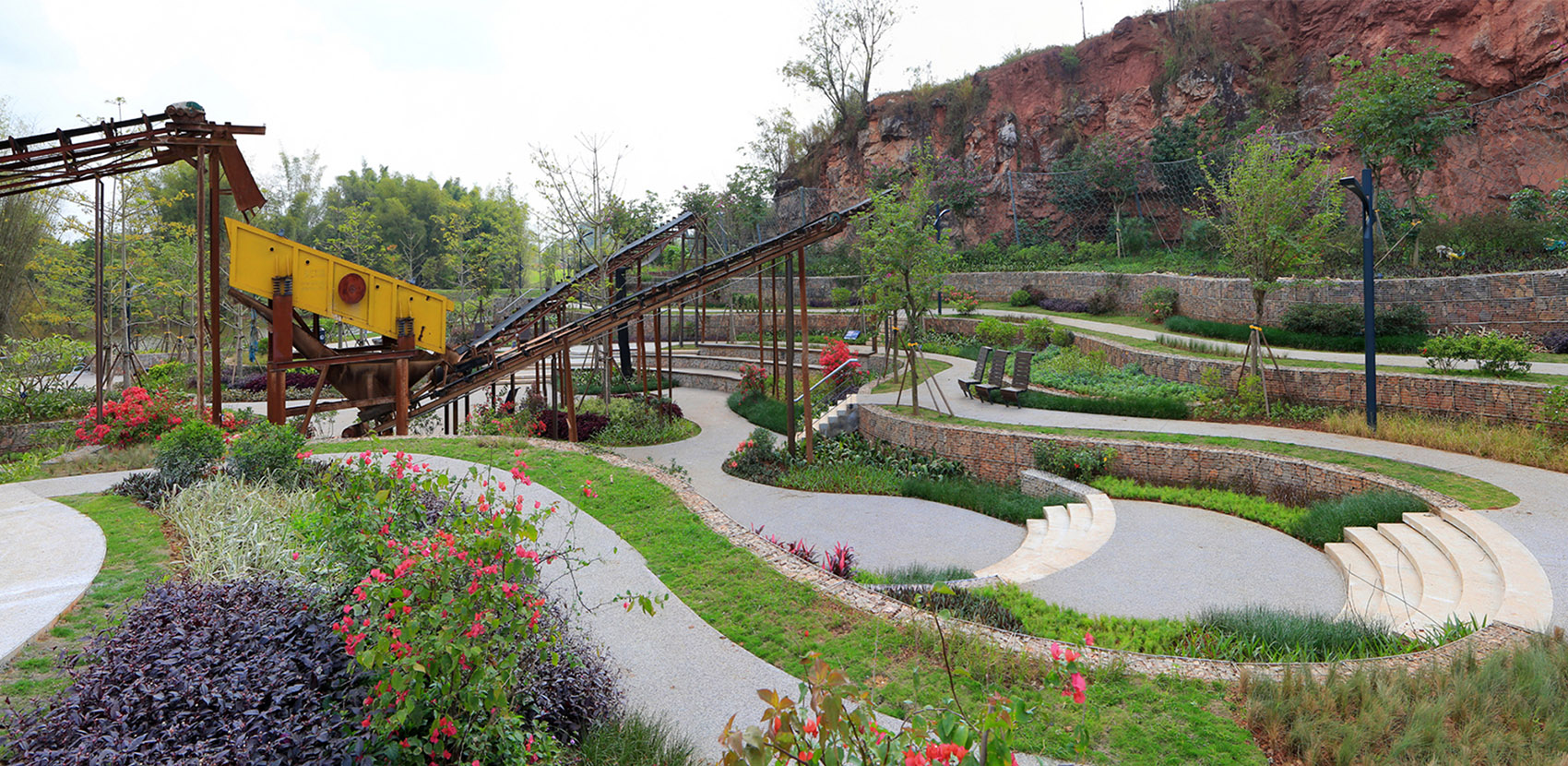
▲具有后工業(yè)氣氛的浪漫絢麗的臺(tái)地花園�,romantic and gorgeous terrace garden with post-industrial atmosphere ? 北京多義景觀規(guī)劃設(shè)計(jì)事務(wù)所
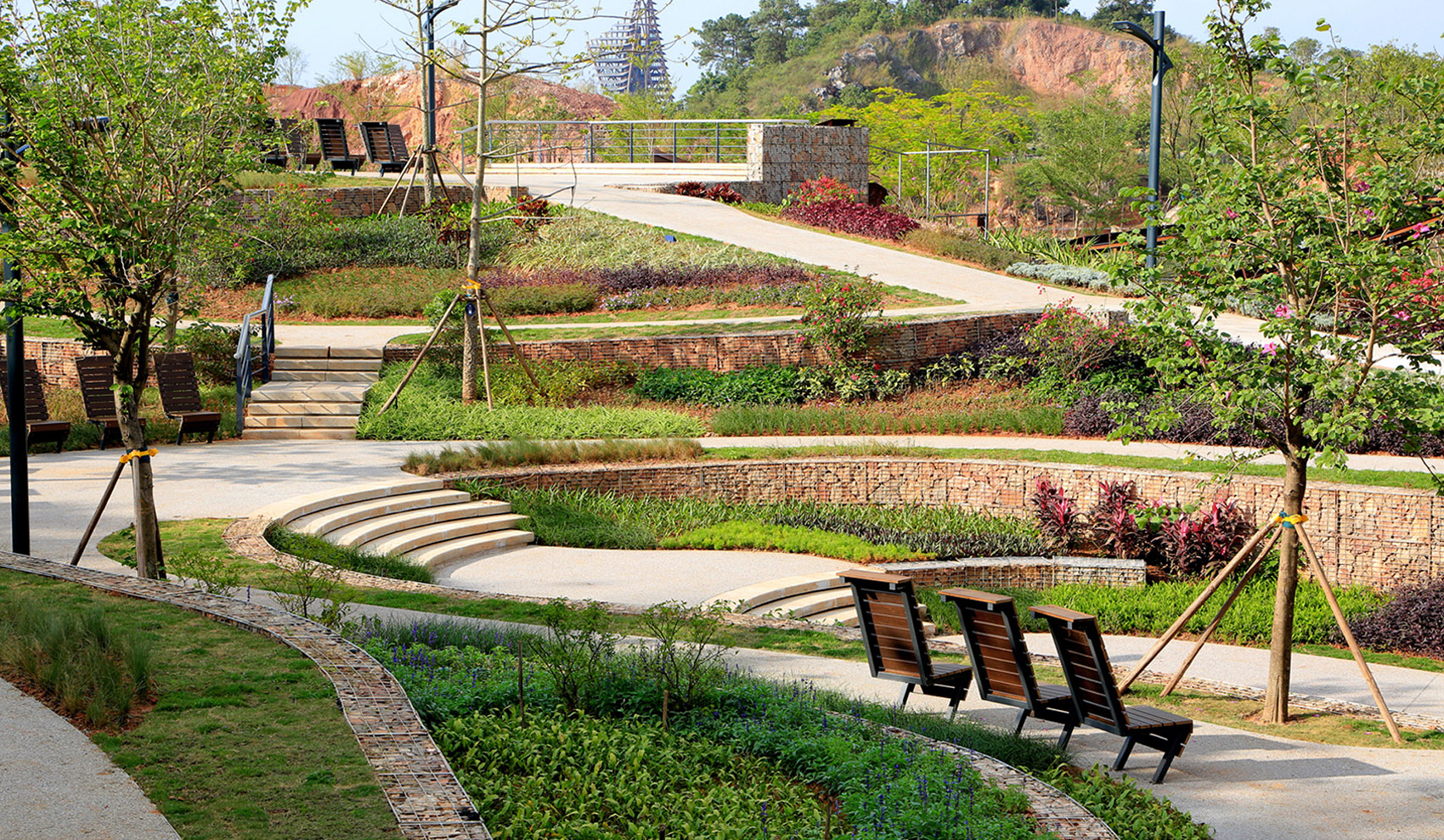
▲不同覆土厚度的臺(tái)地滿足不同植物生長(zhǎng)的需要,various thicknesses of earthing soil meet the needs of plants ? 北京多義景觀規(guī)劃設(shè)計(jì)事務(wù)所
7號(hào)采石場(chǎng)(雙秀園)
Quarry No. 7
這是位于一座小山兩翼的兩個(gè)1000多平方米的小采石坑�����,一個(gè)較深��,終年有水���;另一個(gè)較淺�����,有季節(jié)性積水。因?yàn)閺U棄了若干年����,兩個(gè)坑的石縫里長(zhǎng)出了各種鄉(xiāng)土先鋒植物,景觀樸野自然��。設(shè)計(jì)沒(méi)有采用過(guò)多的人工干預(yù)�����,只在兩個(gè)坑體中間未被開(kāi)采的山坡上設(shè)置了一圈環(huán)形棧道����,讓游人在這里俯視兩側(cè)的采石坑�,讓人們了解在礦坑修復(fù)中自然的力量和作用�。在西側(cè)坑體邊緣設(shè)了一個(gè)臨水小平臺(tái),與山上的環(huán)形棧道相呼應(yīng)��。棧道和平臺(tái)都采用鋼格柵的材料���,透光透水�,不會(huì)影響場(chǎng)地自然植被的恢復(fù)����。
Quarry No. 7 Comprises of two small quarry pits located on two sides of a hill. Abandoned for years, a variety of native pioneer plants have grown out of cracks in the rocks, displaying a natural landscape. With only a few interventions, a ring-shaped walkway skirting the hillside between two pits and a small platform on the edge of the west pit are constructed. They affords visitors a wild view , which demonstrates natural forces and functions in the restoration of quarries. Both walkway and platform adopt steel grating that transmit light and water, preserving the natural vegetation on site.
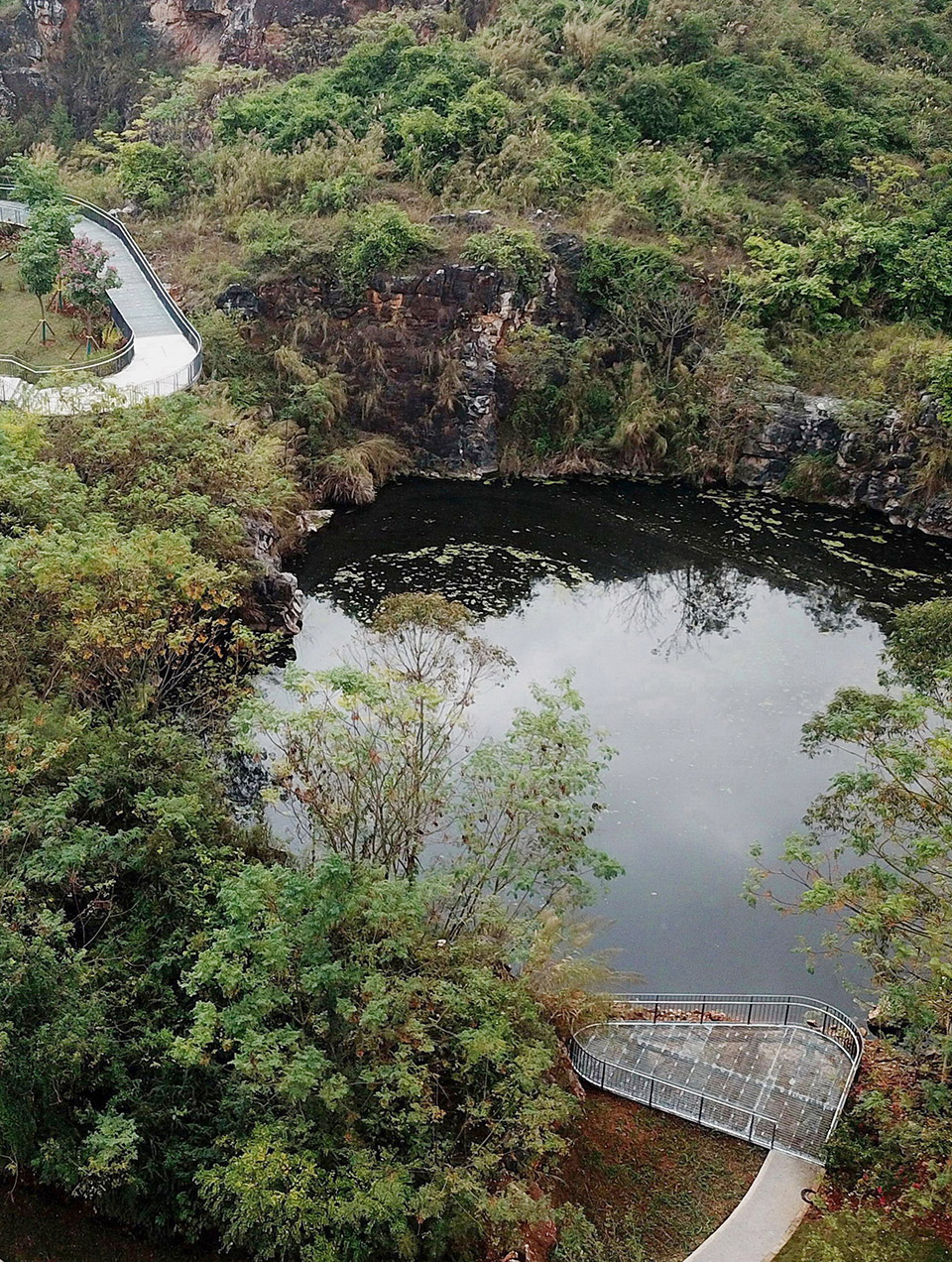
▲7號(hào)采石場(chǎng)概覽 – 山頂?shù)沫h(huán)形棧道和水邊的平臺(tái),overall of the Quarry No. 7:The ring-shaped walkway atop the hill and waterside platform ? 北京多義景觀規(guī)劃設(shè)計(jì)事務(wù)所
通過(guò)契合場(chǎng)地地貌和景觀特征的設(shè)計(jì)�,7個(gè)巖石破碎、荒涼的采石場(chǎng)轉(zhuǎn)變成為了園林博覽會(huì)上獨(dú)特的系列花園��,展現(xiàn)了采石場(chǎng)生態(tài)修復(fù)的可能性和景觀藝術(shù)的不同維度��。它們所展現(xiàn)出來(lái)的思想和方法��,不僅僅在采石場(chǎng)修復(fù)項(xiàng)目中�����、并且在更廣泛的景觀實(shí)踐中具有示范的價(jià)值。
With the design well-fitted with its original landform and landscape features, seven dilapidated and desolate quarries have undergone a fascinating transformation into a series of unique gardens. They demonstrate the promising possibilities and showcase to the public the diversified methods of quarry eco-restoration as well as the multiple dimensions of landscape art.
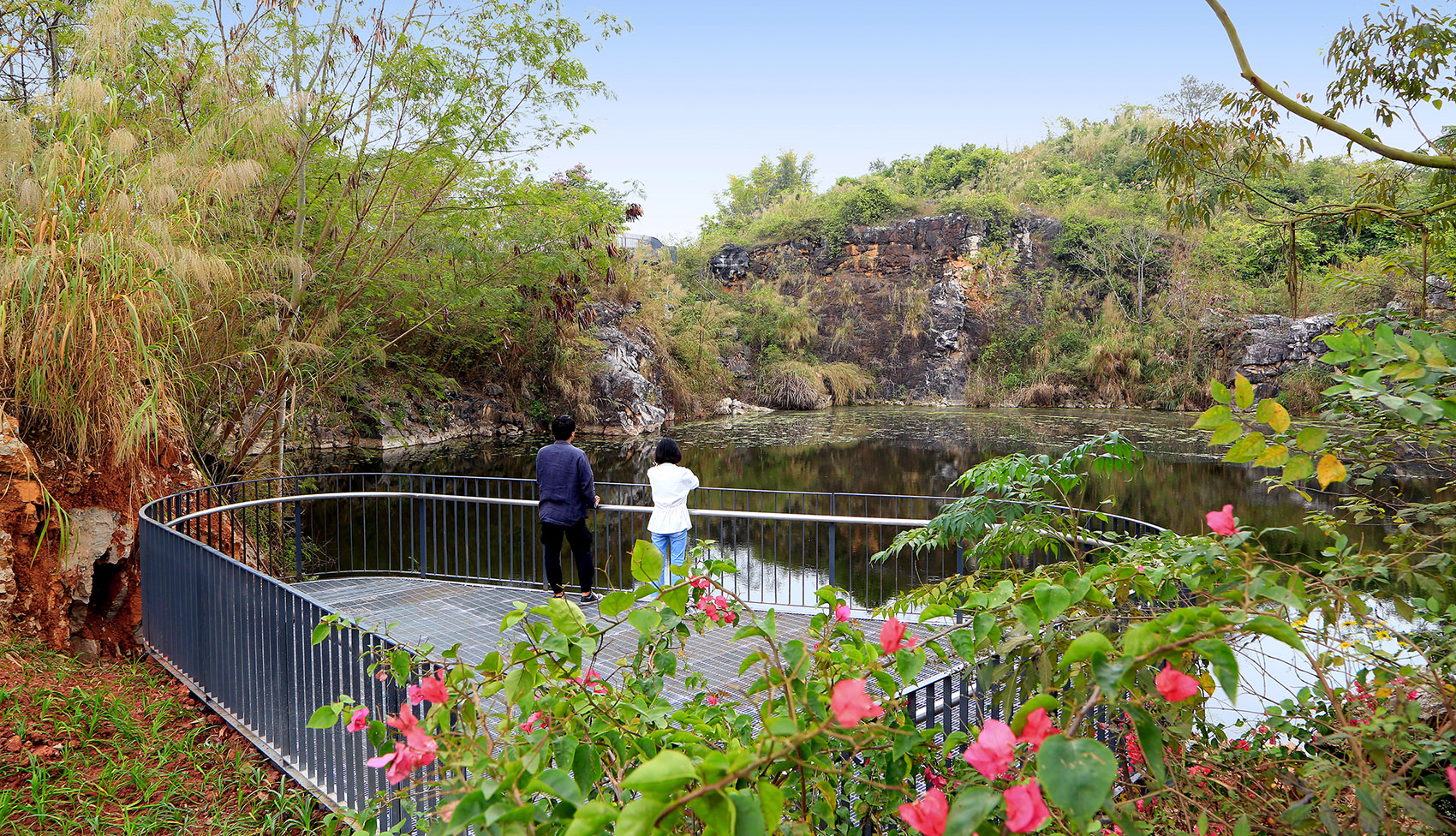
▲荒涼的采石場(chǎng)轉(zhuǎn)變成獨(dú)特的系列花園 �����,desolate quarries transform into a series of unique gardens ? 北京多義景觀規(guī)劃設(shè)計(jì)事務(wù)所
場(chǎng)地上原有一道水渠����,是場(chǎng)地農(nóng)業(yè)歷史的見(jiàn)證。我們?cè)谠O(shè)計(jì)中保留了水渠�,將它作為該區(qū)域幾個(gè)水面的補(bǔ)水水源,延續(xù)它原有的功能��,并水渠上方架設(shè)高架步行橋���,與相臨的采石場(chǎng)花園的游覽路徑連接起來(lái)����,形成該區(qū)域獨(dú)特的立體游覽體系��。為了給游客提供一些基本服務(wù)�����,同時(shí)也展示園區(qū)生態(tài)修復(fù)的理念和方法��,我們?cè)诓墒瘓?chǎng)區(qū)域設(shè)計(jì)了一個(gè)600m2的信息亭����。木結(jié)構(gòu)的建筑呼應(yīng)了當(dāng)?shù)剜l(xiāng)土建筑的形式。
An existing aqueduct runs across the site, transporting water from nearby spring to surrounding villages and farms. As a witness of site’s agricultural history, it is well-preserved for irrigation water supply of the area, retaining its original function. Above the aqueduct is a pedestrian bridge that connects to the paths toward the adjacent quarry gardens, creating a unique three-dimensional tour system in this area. A 600m2 pavilion provides various tourist services such as sales, rest, shuttle bus ticketing, etc., and also showcases the history and eco-restoration processes and methods of the quarry gardens.
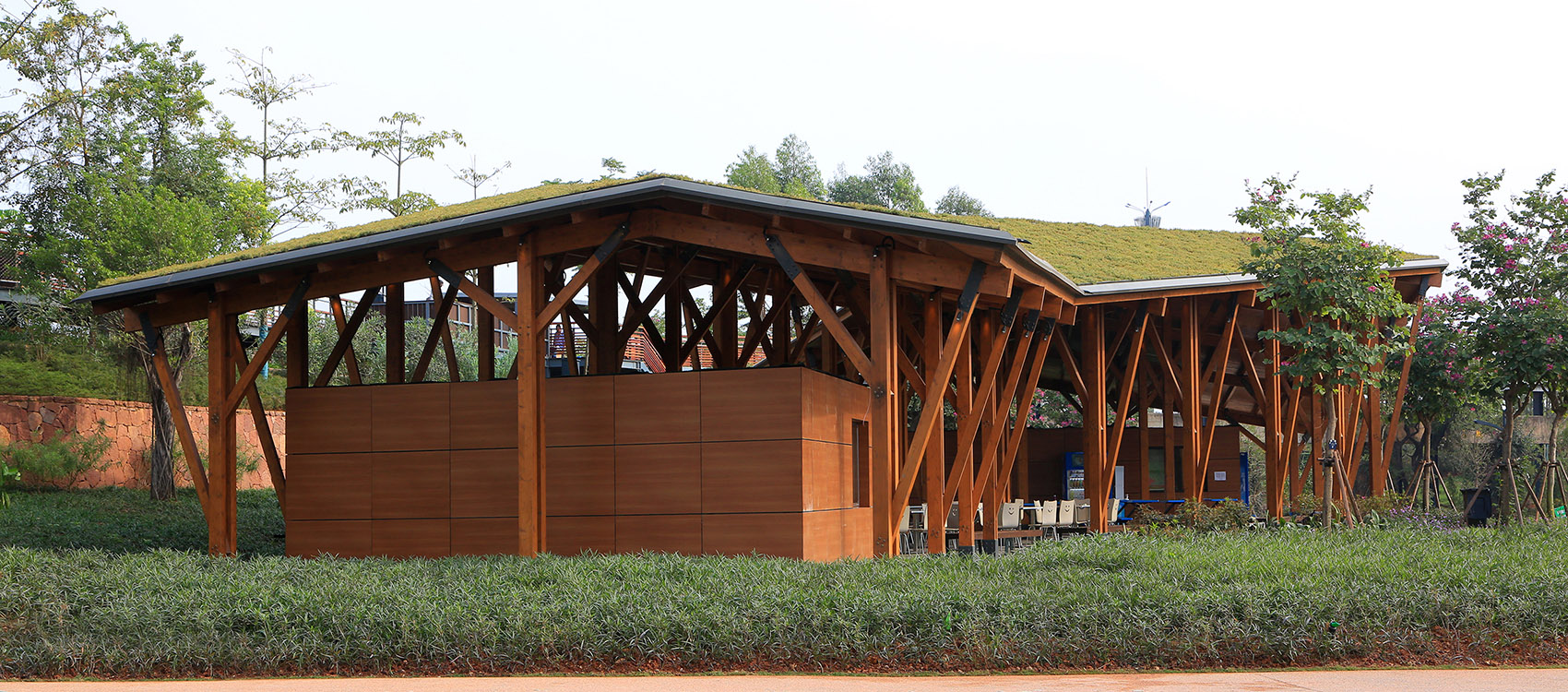
▲木結(jié)構(gòu)的信息亭�,pavilion with wooden structure ? 北京多義景觀規(guī)劃設(shè)計(jì)事務(wù)所
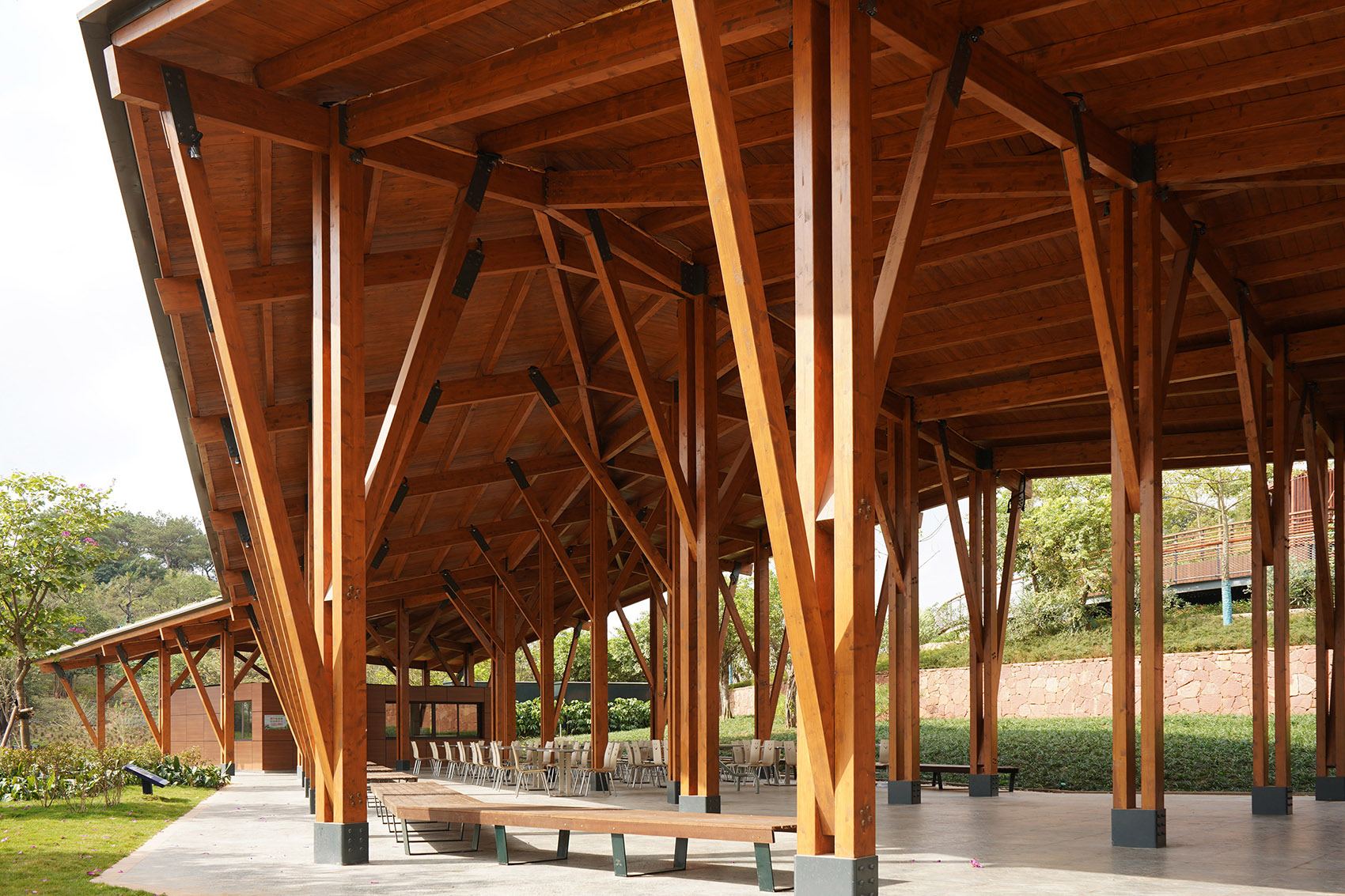
▲信息亭細(xì)部,details of the pavilion ? 北京多義景觀規(guī)劃設(shè)計(jì)事務(wù)所
項(xiàng)目名稱:南寧園博園采石場(chǎng)花園
設(shè)計(jì)方:北京多義景觀規(guī)劃設(shè)計(jì)事務(wù)所
公司網(wǎng)站:http://www.dylandscape.com/
聯(lián)系郵箱:375398164@qq.com
項(xiàng)目設(shè)計(jì) & 完成年份:2016-2018年
主創(chuàng):王向榮���、林箐
設(shè)計(jì)團(tuán)隊(duì):李倞�、張?jiān)婈?yáng)��、劉通��、李洋��、張銘然�����、鄭小東��、華銳���、韓宇����、許璐、金佳鑫���、趙真真��、王譞���、常弘、杜紅娟���、崔慶偉�����、張雪葳�����、王越、李恒���、王晞月���、譚立�����、張雨生���、滿媛、李雯
項(xiàng)目地址:廣西省南寧市
場(chǎng)地面積:35ha
攝影師:孫國(guó)棟�、李嬋、周仕凡���、林箐��、王資清
攝影版權(quán):北京多義景觀規(guī)劃設(shè)計(jì)事務(wù)所
客戶:南寧市林業(yè)和園林管理局
獲獎(jiǎng)情況:
2019年英國(guó)國(guó)家景觀協(xié)會(huì)(BALI)國(guó)家景觀獎(jiǎng)
2020年美國(guó)風(fēng)景園林師協(xié)會(huì)(ASLA)綜合設(shè)計(jì)獎(jiǎng)
Project name:Quarry Gardens In Nanning Garden Expo Park
Design:Atelier DYJG
Website:http://www.dylandscape.com/
Contact e-mail:375398164@qq.com
Design year & Completion Year:2016-2018
Leader designer:Wang Xiangrong Lin Qing
Team:Li Liang����、Zhang Shiyang����、Liu Tong、Li Yang���、Zhang Mingran�����、Zheng Xiaodong����、Hua Rui、Han Yu�、Xu Lu、Jin Jiaxin��、Zhao Zhenzhen���、Wang Xuan���、Chang Hong、Du Hongjuan���、Cui Qingwei���、Zhang Xuewei、Wang Yue�、Li Heng�、Wang Xiyue���、Tan Li、Zhang Yusheng����、Man Yuan、Li Wen
Project location:Nanning, Guanxi Province
Gross Built Area (square meters):35ha
Photographer:Sun Guodong����、Li Chan、Zhou Shifan�、Lin Qing、Wang Ziqing
Photo credits:Atelier DYJG
Clients:Nanning forestry and Landscape Management Bureau
版權(quán)聲明:本文版權(quán)歸原作者所有�,如有侵犯您的權(quán)益請(qǐng)及時(shí)聯(lián)系,我們將第一時(shí)間刪除�����。
投稿郵箱:info@landscape.cn
項(xiàng)目咨詢:18510568018(微信同號(hào))
 京公海網(wǎng)安備 110108000058號(hào)
京公海網(wǎng)安備 110108000058號(hào)






















